
FLAME
[AAAI-25 Oral] Official Implementation of "FLAME: Learning to Navigate with Multimodal LLM in Urban Environments"
Stars: 61
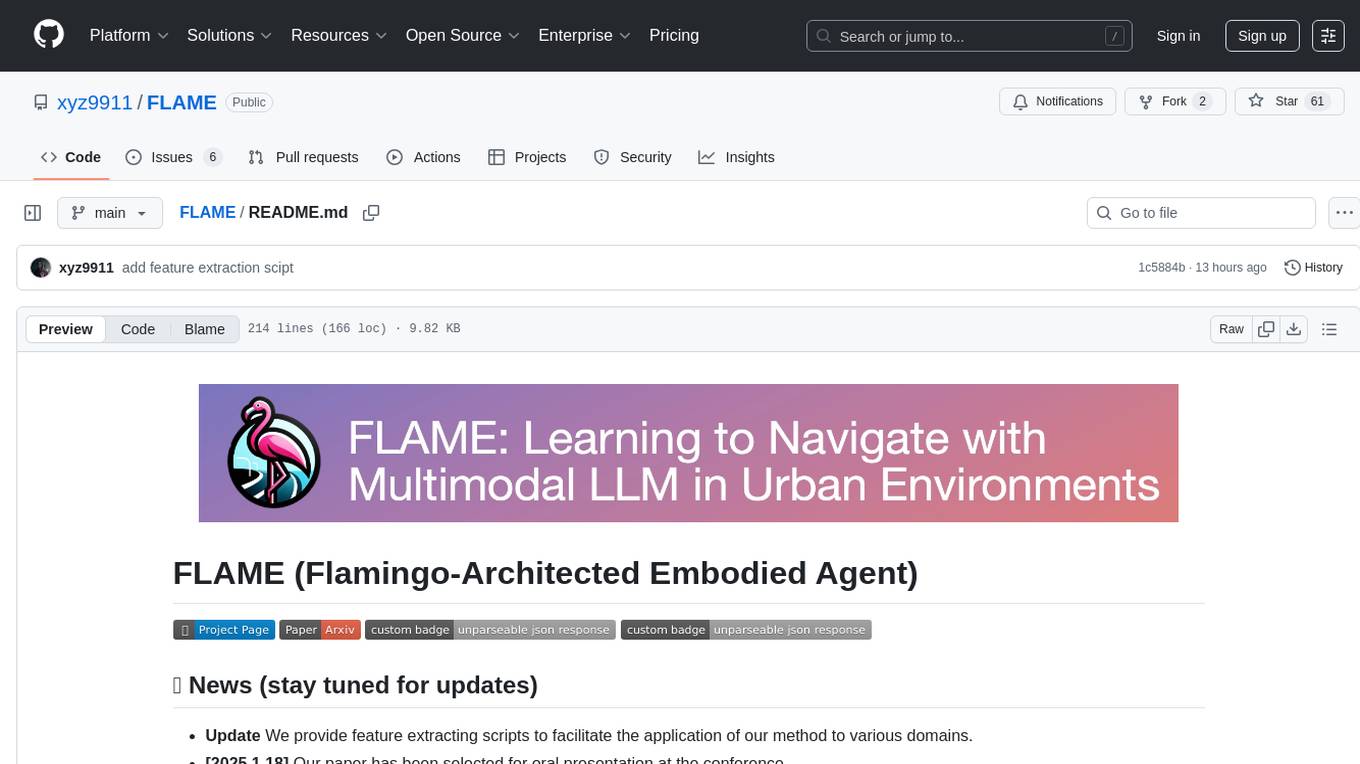
FLAME is a lightweight and efficient deep learning framework designed for edge devices. It provides a simple and user-friendly interface for developing and deploying deep learning models on resource-constrained devices. With FLAME, users can easily build and optimize neural networks for tasks such as image classification, object detection, and natural language processing. The framework supports various neural network architectures and optimization techniques, making it suitable for a wide range of applications in the field of edge computing.
README:
- Update We provide feature extracting scripts to facilitate the application of our method to various domains.
- [2025.1.18] Our paper has been selected for oral presentation at the conference.
- [2024.12.27] We release code for reproducing the SOTA results.
- [2024.12.9] Our paper is accepted by AAAI 2025.
- [2024.8.20] We release the paper and the webpage of our project.
Large Language Models (LLMs) have demonstrated potential in Vision-and-Language Navigation (VLN) tasks, yet current applications face challenges. While LLMs excel in general conversation scenarios, they struggle with specialized navigation tasks, yielding suboptimal performance compared to specialized VLN models. We introduce FLAME (FLAMingo-Architected Embodied Agent), a novel Multimodal LLM-based agent and architecture designed for urban VLN tasks that efficiently handles multiple observations. Our approach implements a three-phase tuning technique for effective adaptation to navigation tasks, including single perception tuning for street view description, multiple perception tuning for route summarization, and end-to-end training on VLN datasets. The augmented datasets are synthesized automatically. Experimental results demonstrate FLAME's superiority over existing methods, surpassing state-of-the-art methods by a 7.3% increase in task completion on Touchdown dataset. This work showcases the potential of Multimodal LLMs (MLLMs) in complex navigation tasks, representing an advancement towards applications of MLLMs in the field of embodied intelligence.
Based on Flamingo, FLAME operates autoregressively and efficiently handles multiple perceptions without increasing context length, ensuring efficiency in end-to-end training and inference.
Our approach implements a three-phase tuning technique for effective adaptation to navigation tasks, including single perception tuning for street view description, multiple perception tuning for simple navigation scenario and trajectory summarization, and end-to-end training on VLN datasets. The augmented datasets are synthesized automatically.
FLAME is implemented based on Otter and OpenFlamingo. The training is based on DeepSpeed. We provide code for end-to-end training (navigation tuning) and evaluation on the Touchdown and Map2seq datasets.
-
Create a dataset directory and install dependencies:
mkdir dataset conda create --name flame python=3.10 conda activate flame pip install -r requirements.txt -
Download the outdoor VLN dataset from Hugging Face and place the downloaded data in the
datasetfolder. (For the panoramas, you have to request and download from https://sites.google.com/view/streetlearn/dataset, though the provided CLIP features is sufficient for training and evaluation.) Merge and unpack CLIP features fromtouchdown_feature.tar*before use:cat touchdown_feature.tar* > touchdown_feature.tar tar -xvf touchdown_feature.tar -
(Optional) Download the pretrained checkpoint (with 2-phase tuning) from Hugging Face and place it in a custom folder. You need to specify the model_path in the training arguments.
We provide several training scripts (in the 'scripts' folder) using DeepSpeed ZERO-1 by default:
Basic Training (SOTA Results):
-
ds_ft_touchdown.sh: Touchdown dataset -
ds_ft_map2seq.sh: Map2seq dataset
Rationale Training:
-
ds_ft_touchdown_rationale.sh: Touchdown subset with rationales -
ds_ft_map2seq_rationale.sh: Map2seq subset with rationales
Usage:
# Single GPU (recommended)
bash scripts/ds_ft_touchdown.sh <GPU_ID>
# Multi-GPU (e.g., GPUs 0,1)
bash scripts/ds_ft_touchdown.sh <GPU_IDS>Example:
bash scripts/ds_ft_touchdown.sh 0For better stability or when DeepSpeed is not available:
python train_flame.py \
--model_path </path/to/pretrained_model> \
--train_if_data_path </path/to/ft_train_data> \
--eval_if_data_path </path/to/ft_dev_data> \
--dataset </path/to/data> \
--img_db "dataset/touchdown_feature" \
--batch_size 64 \
--micro_batch_size 1 \
--eval_data_size 128 \
--env_batch_size 4 \
--tf32 True \
--learning_rate 1e-4 \
--lr_scheduler_type "cosine" \
--warmup_ratio 0.01 \
--save_steps 100 \
--eval_steps 100 \
--num_train_epochs <epochs> \Basic Evaluation:
-
nav_touchdown.sh: Touchdown dataset -
nav_map2seq.sh: Map2seq dataset
Usage:
bash scripts/nav_touchdown.sh <GPU_ID> <checkpoint_dir> <split> <checkpoint_numbers>Example:
bash scripts/nav_touchdown.sh 0 checkpoints dev 1600 1700 1800Parameters:
-
GPU_ID: GPU ID -
checkpoint_dir: Directory containing checkpoints -
split: Dataset split (dev or test) -
checkpoint_numbers: Space-separated checkpoint steps to evaluate
Evaluation with Self-Consistency:
-
nav_touchdown_rationale.sh: Touchdown subset with rationales -
nav_map2seq_rationale.sh: Map2seq subset with rationales
Usage:
bash scripts/nav_touchdown_rationale.sh <GPU_ID> <checkpoint_dir> <split> <temperature> <decoding_paths> <checkpoint_numbers>Example:
bash scripts/nav_touchdown_rationale.sh 0 checkpoints 1.0 8 1600 1700 1800Parameters:
-
temperature: Controls prediction randomness (0.0 for deterministic) -
decoding_paths: Number of sampled trajectories
- In-training evaluation uses a subset (10%) of validation data for efficiency
- Always perform full evaluation on saved checkpoints after training
- When using DeepSpeed, apply early stopping around 2500 steps
- Learning rate defaults to 1e-4
- Batch size defaults to 64 in single-gpu mode (needs to be adjusted based on the world size)
- BF16 training requires Ampere or newer GPUs
- For older GPUs:
- Use FP16 with DeepSpeed
- Or use full precision training with FP32
FLAME achieves state-of-the-art results on both the Touchdown and Map2seq datasets. The table below highlights FLAME's performance compared to previous models.
| Model | TC↑ (Dev) | SPD↓ (Dev) | nDTW↑ (Dev) | TC↑ (Test) | SPD↓ (Test) | nDTW↑ (Test) |
|---|---|---|---|---|---|---|
| RCONCAT (2019) | 10.60 | 20.4 | 22.50 | 11.80 | 20.40 | 22.90 |
| GA (2019) | 12.00 | 18.70 | 25.20 | 11.90 | 19.00 | 24.90 |
| VLN-Trans (2021) | 15.00 | 20.30 | 27.00 | 16.20 | 20.80 | 27.80 |
| ARC+L2S (2020) | 19.48 | 17.05 | - | 16.68 | 18.84 | - |
| ORAR (2022) | 30.05 | 11.12 | 45.50 | 29.60 | 11.79 | 45.30 |
| VELMA (2023) | 29.83 | 14.67 | 43.44 | 27.38 | 15.03 | 41.93 |
| PM-VLN (2023) | 33.00 | 23.60 | - | 33.40 | 23.80 | - |
| VLN-Video (2024) | 34.50 | 9.60 | - | 31.70 | 11.20 | - |
| Loc4Plan (2024) | 34.50 | 10.50 | - | 32.90 | 11.50 | - |
| FLAME | 41.28 | 9.14 | 55.96 | 40.20 | 9.53 | 54.56 |
| Model | TC↑ (Dev) | SPD↓ (Dev) | nDTW↑ (Dev) | TC↑ (Test) | SPD↓ (Test) | nDTW↑ (Test) |
|---|---|---|---|---|---|---|
| RCONCAT (2019) | 17.10 | - | 30.70 | 14.70 | - | 27.70 |
| GA (2019) | 18.20 | - | 33.00 | 17.00 | - | 30.10 |
| VLN-Trans (2021) | 18.60 | - | 31.10 | 17.00 | - | 29.50 |
| ORAR (2022) | 49.88 | 5.87 | 62.70 | 47.75 | 6.53 | 62.10 |
| VELMA (2023) | 52.75 | 6.78 | 66.45 | 48.70 | 6.80 | 62.37 |
| Loc4Plan (2024) | 48.00 | 7.00 | - | 45.30 | 7.20 | - |
| FLAME | 56.95 | 5.95 | 71.36 | 52.44 | 5.91 | 67.72 |
FLAME consistently outperforms prior models, proving that MLLMs can significantly outperform specialized VLN models.
We sincerely thank the Otter team and the OpenFlamingo team for their great contribution to the Flamingo-architected Multimodal Large Language Models.
If you find our research useful, please cite our paper:
@article{xu2024flame,
title={FLAME: Learning to Navigate with Multimodal LLM in Urban Environments},
author={Xu, Yunzhe and Pan, Yiyuan and Liu, Zhe and Wang, Hesheng},
journal={arXiv preprint arXiv:2408.11051},
year={2024}}
For Tasks:
Click tags to check more tools for each tasksFor Jobs:
Alternative AI tools for FLAME
Similar Open Source Tools

FLAME
FLAME is a lightweight and efficient deep learning framework designed for edge devices. It provides a simple and user-friendly interface for developing and deploying deep learning models on resource-constrained devices. With FLAME, users can easily build and optimize neural networks for tasks such as image classification, object detection, and natural language processing. The framework supports various neural network architectures and optimization techniques, making it suitable for a wide range of applications in the field of edge computing.
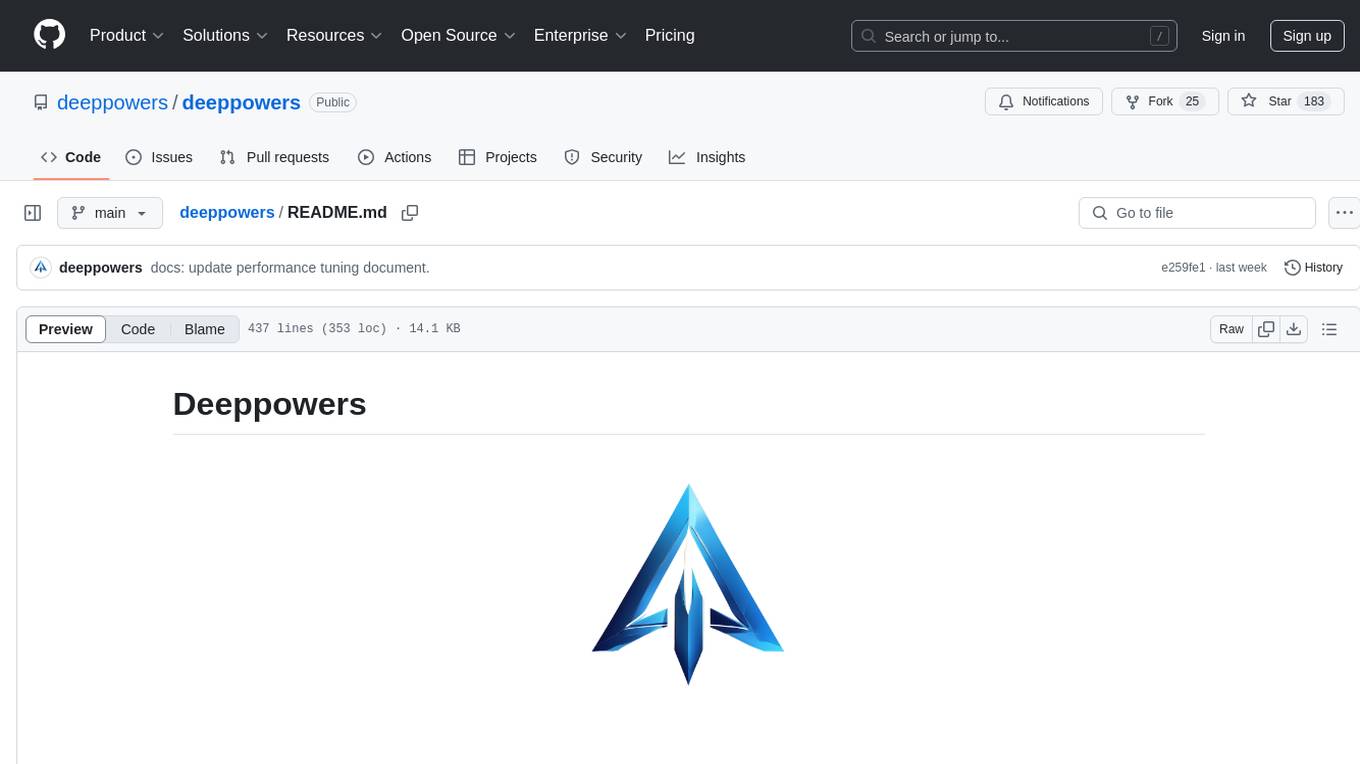
deeppowers
Deeppowers is a powerful Python library for deep learning applications. It provides a wide range of tools and utilities to simplify the process of building and training deep neural networks. With Deeppowers, users can easily create complex neural network architectures, perform efficient training and optimization, and deploy models for various tasks. The library is designed to be user-friendly and flexible, making it suitable for both beginners and experienced deep learning practitioners.
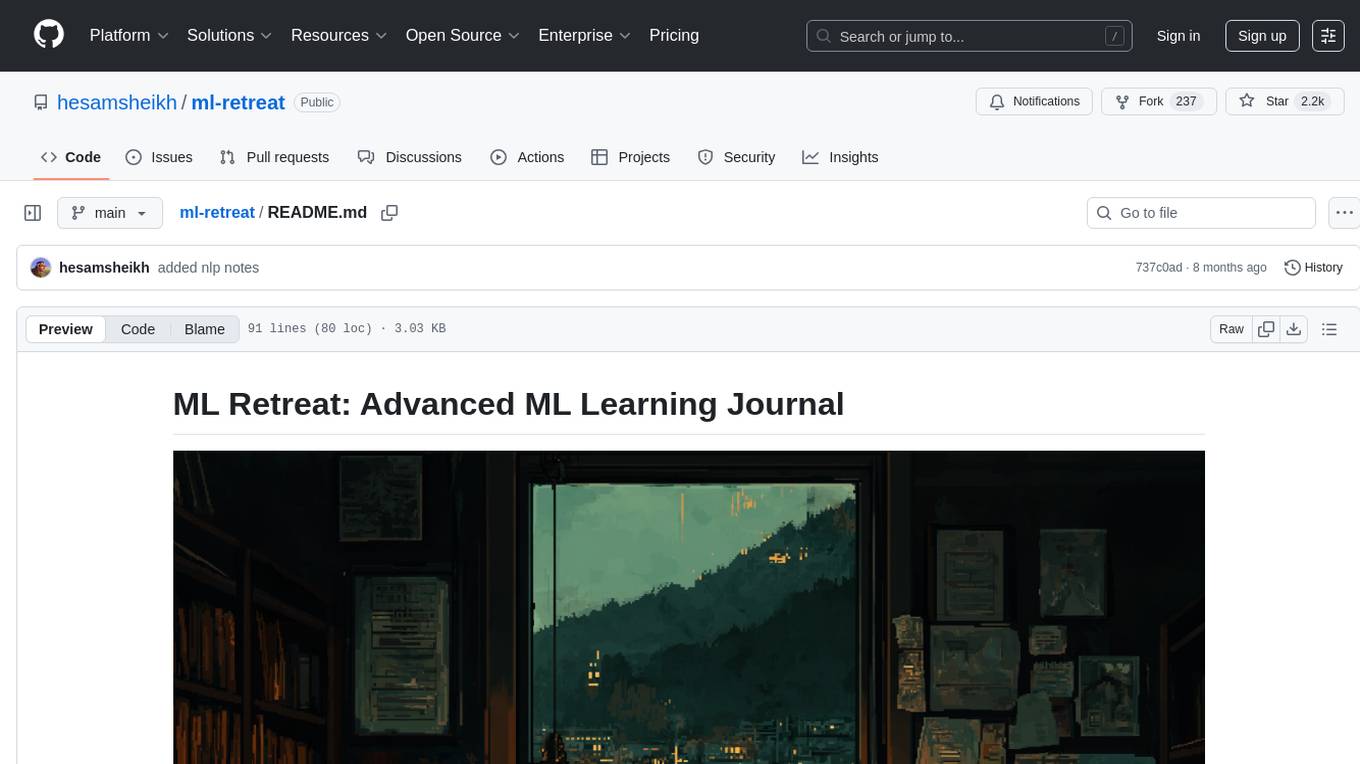
ml-retreat
ML-Retreat is a comprehensive machine learning library designed to simplify and streamline the process of building and deploying machine learning models. It provides a wide range of tools and utilities for data preprocessing, model training, evaluation, and deployment. With ML-Retreat, users can easily experiment with different algorithms, hyperparameters, and feature engineering techniques to optimize their models. The library is built with a focus on scalability, performance, and ease of use, making it suitable for both beginners and experienced machine learning practitioners.
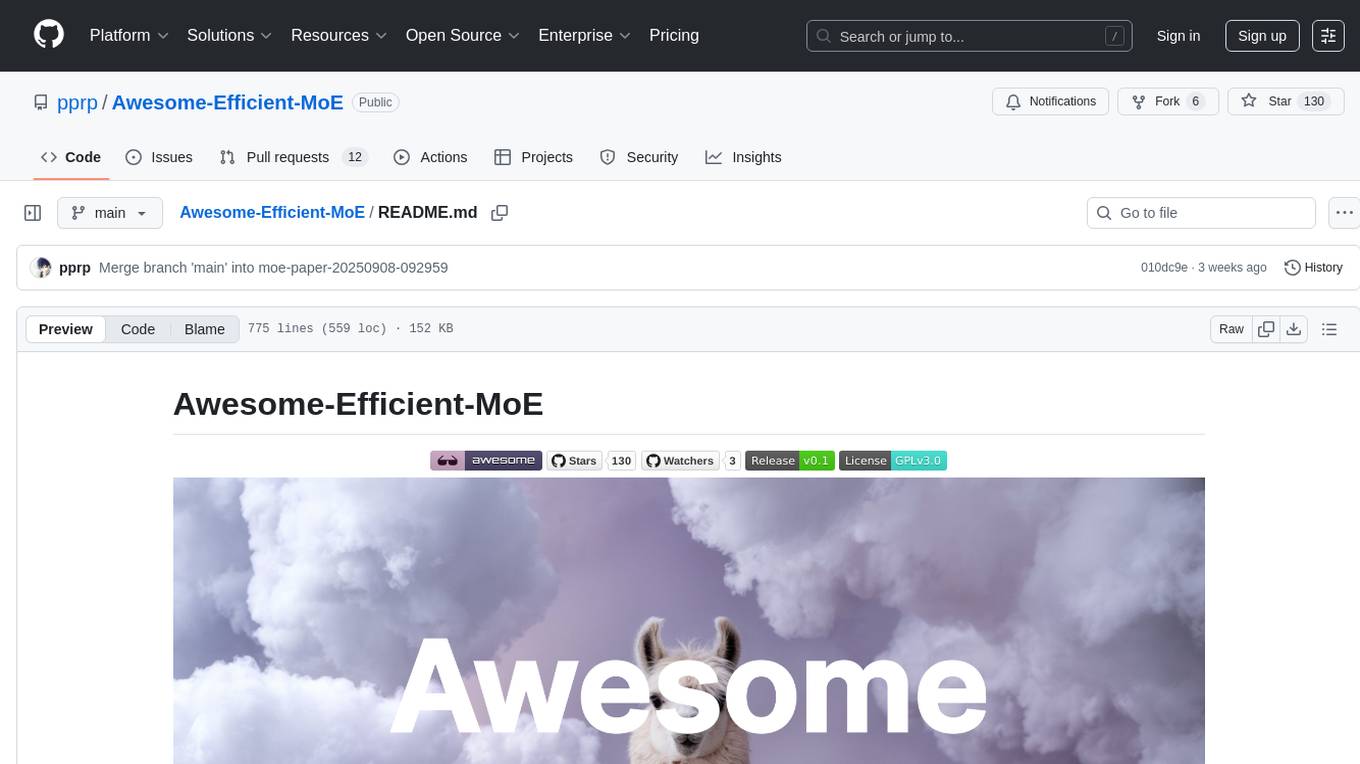
Awesome-Efficient-MoE
Awesome Efficient MoE is a GitHub repository that provides an implementation of Mixture of Experts (MoE) models for efficient deep learning. The repository includes code for training and using MoE models, which are neural network architectures that combine multiple expert networks to improve performance on complex tasks. MoE models are particularly useful for handling diverse data distributions and capturing complex patterns in data. The implementation in this repository is designed to be efficient and scalable, making it suitable for training large-scale MoE models on modern hardware. The code is well-documented and easy to use, making it accessible for researchers and practitioners interested in leveraging MoE models for their deep learning projects.
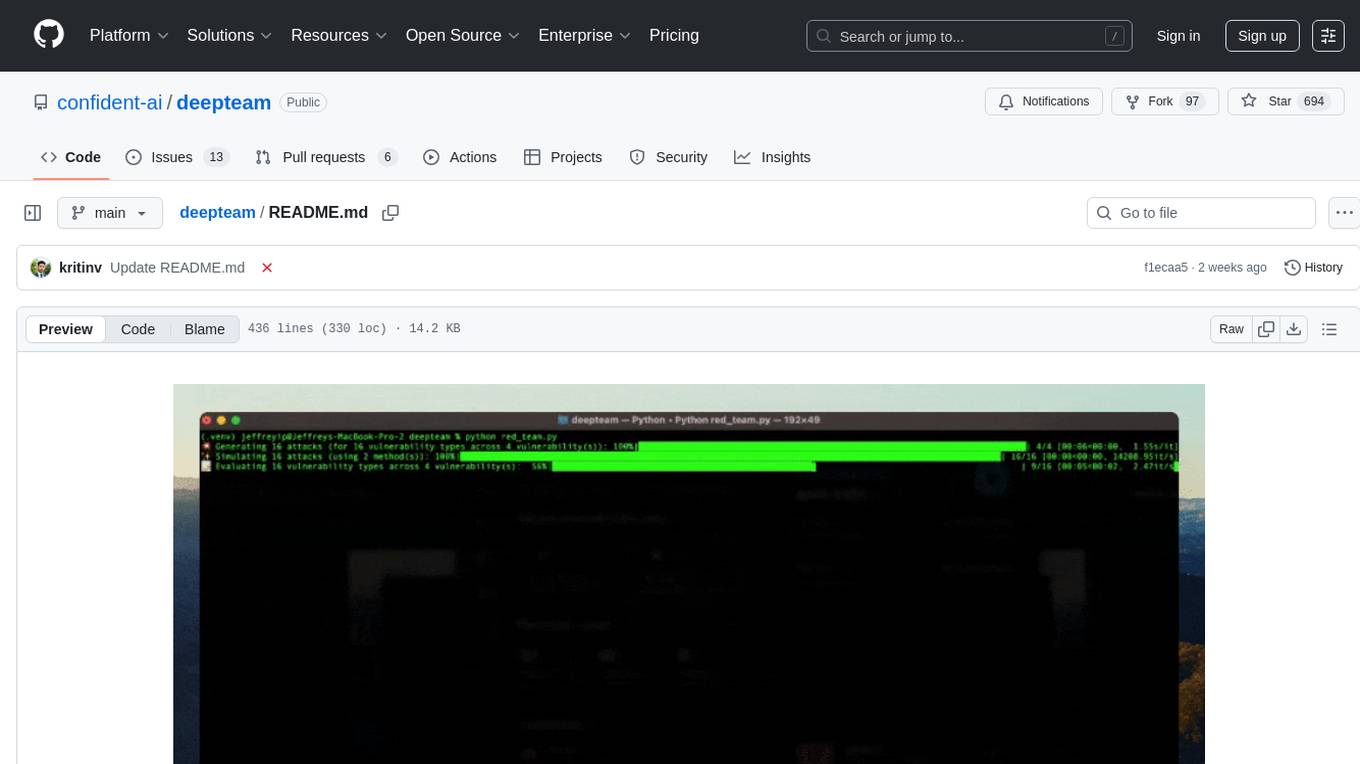
deepteam
Deepteam is a powerful open-source tool designed for deep learning projects. It provides a user-friendly interface for training, testing, and deploying deep neural networks. With Deepteam, users can easily create and manage complex models, visualize training progress, and optimize hyperparameters. The tool supports various deep learning frameworks and allows seamless integration with popular libraries like TensorFlow and PyTorch. Whether you are a beginner or an experienced deep learning practitioner, Deepteam simplifies the development process and accelerates model deployment.
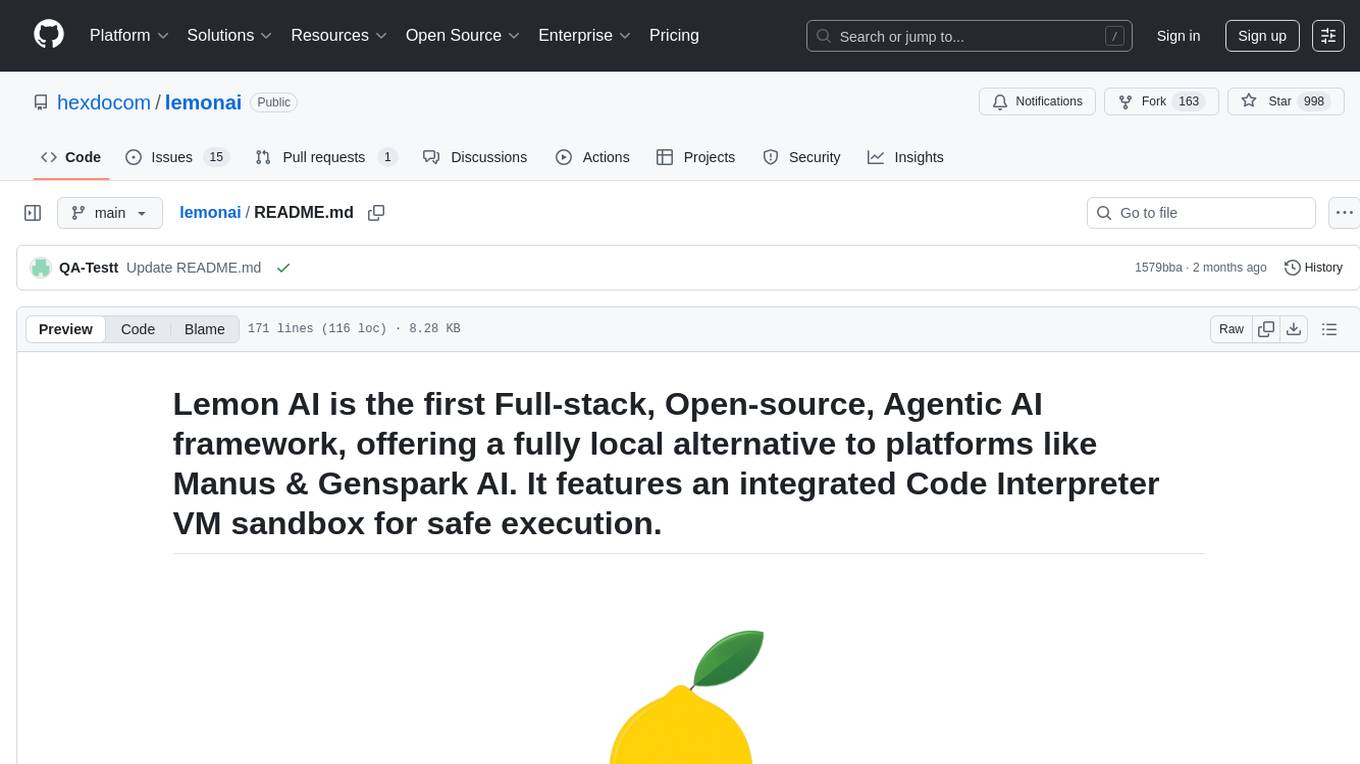
lemonai
LemonAI is a versatile machine learning library designed to simplify the process of building and deploying AI models. It provides a wide range of tools and algorithms for data preprocessing, model training, and evaluation. With LemonAI, users can easily experiment with different machine learning techniques and optimize their models for various tasks. The library is well-documented and beginner-friendly, making it suitable for both novice and experienced data scientists. LemonAI aims to streamline the development of AI applications and empower users to create innovative solutions using state-of-the-art machine learning methods.
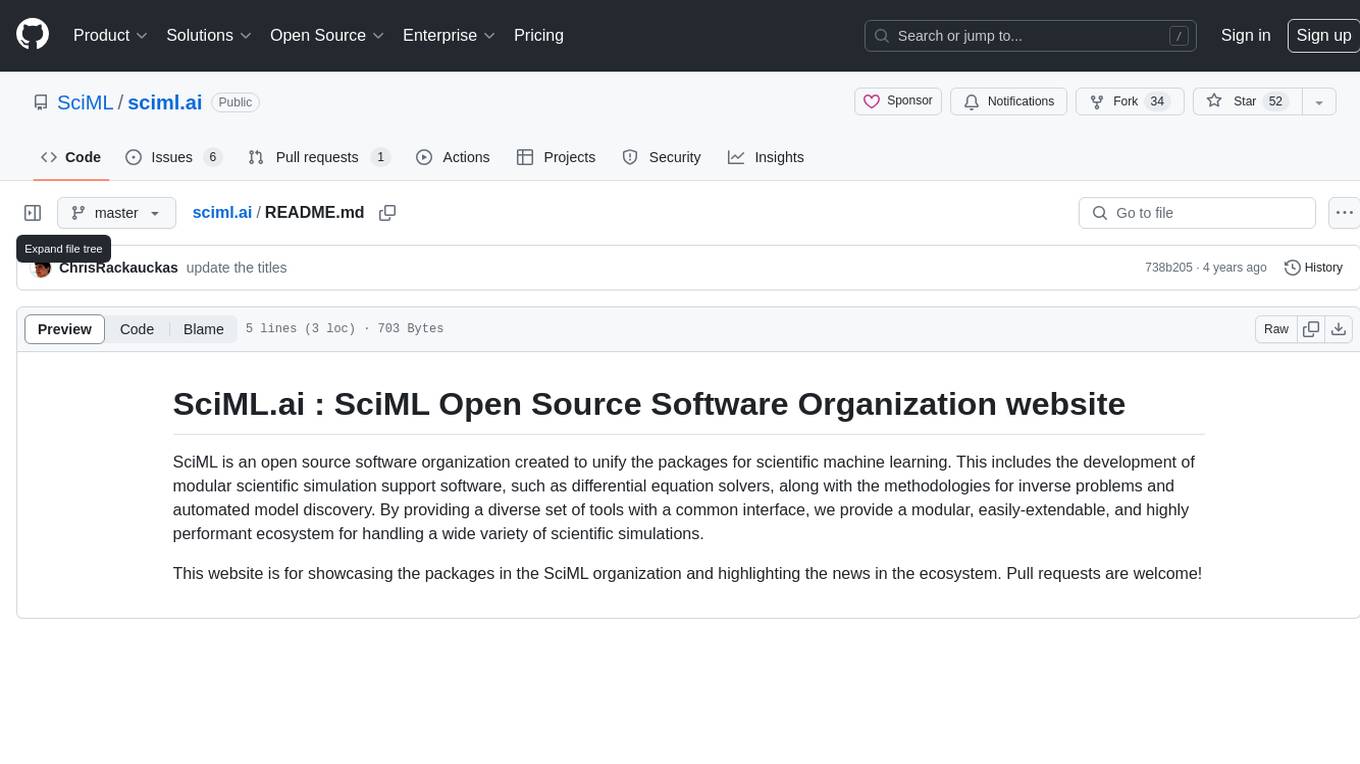
sciml.ai
SciML.ai is an open source software organization dedicated to unifying packages for scientific machine learning. It focuses on developing modular scientific simulation support software, including differential equation solvers, inverse problems methodologies, and automated model discovery. The organization aims to provide a diverse set of tools with a common interface, creating a modular, easily-extendable, and highly performant ecosystem for scientific simulations. The website serves as a platform to showcase SciML organization's packages and share news within the ecosystem. Pull requests are encouraged for contributions.
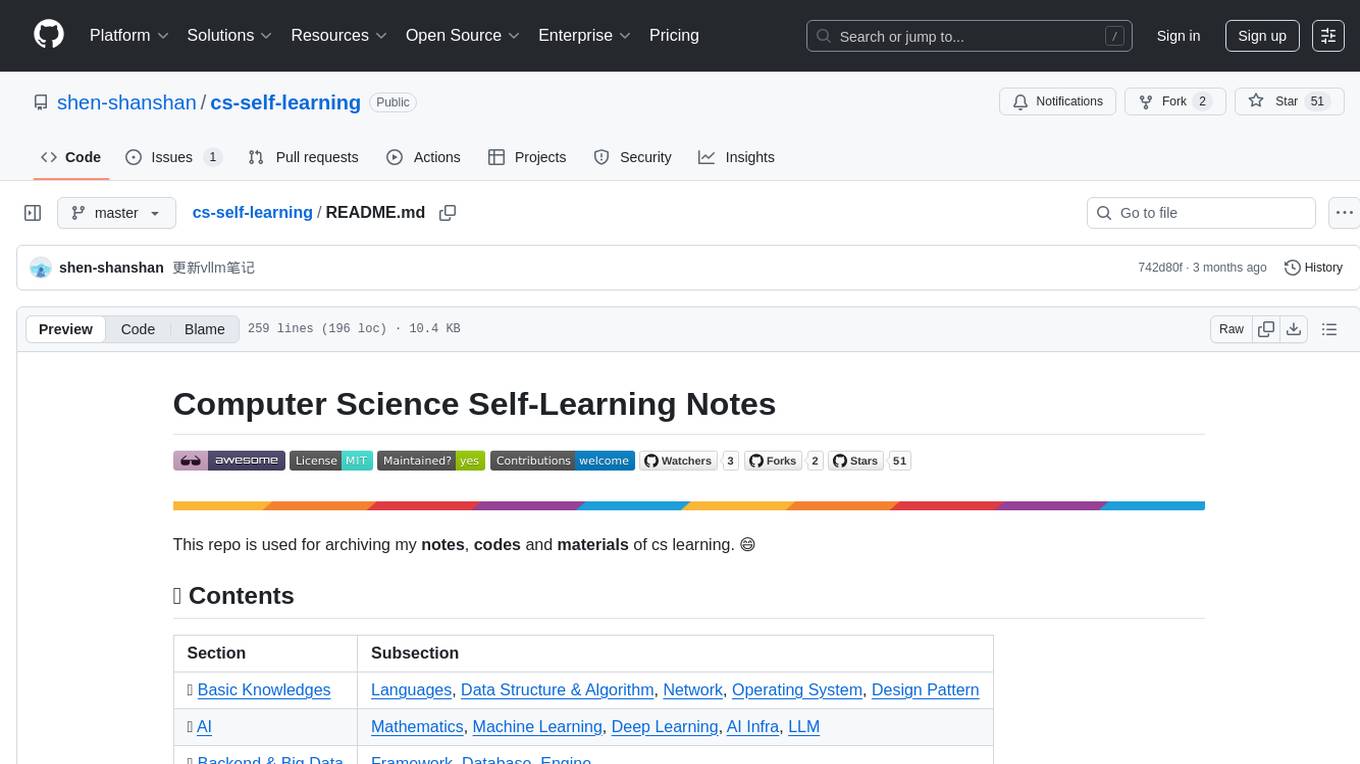
cs-self-learning
This repository serves as an archive for computer science learning notes, codes, and materials. It covers a wide range of topics including basic knowledge, AI, backend & big data, tools, and other related areas. The content is organized into sections and subsections for easy navigation and reference. Users can find learning resources, programming practices, and tutorials on various subjects such as languages, data structures & algorithms, AI, frameworks, databases, development tools, and more. The repository aims to support self-learning and skill development in the field of computer science.
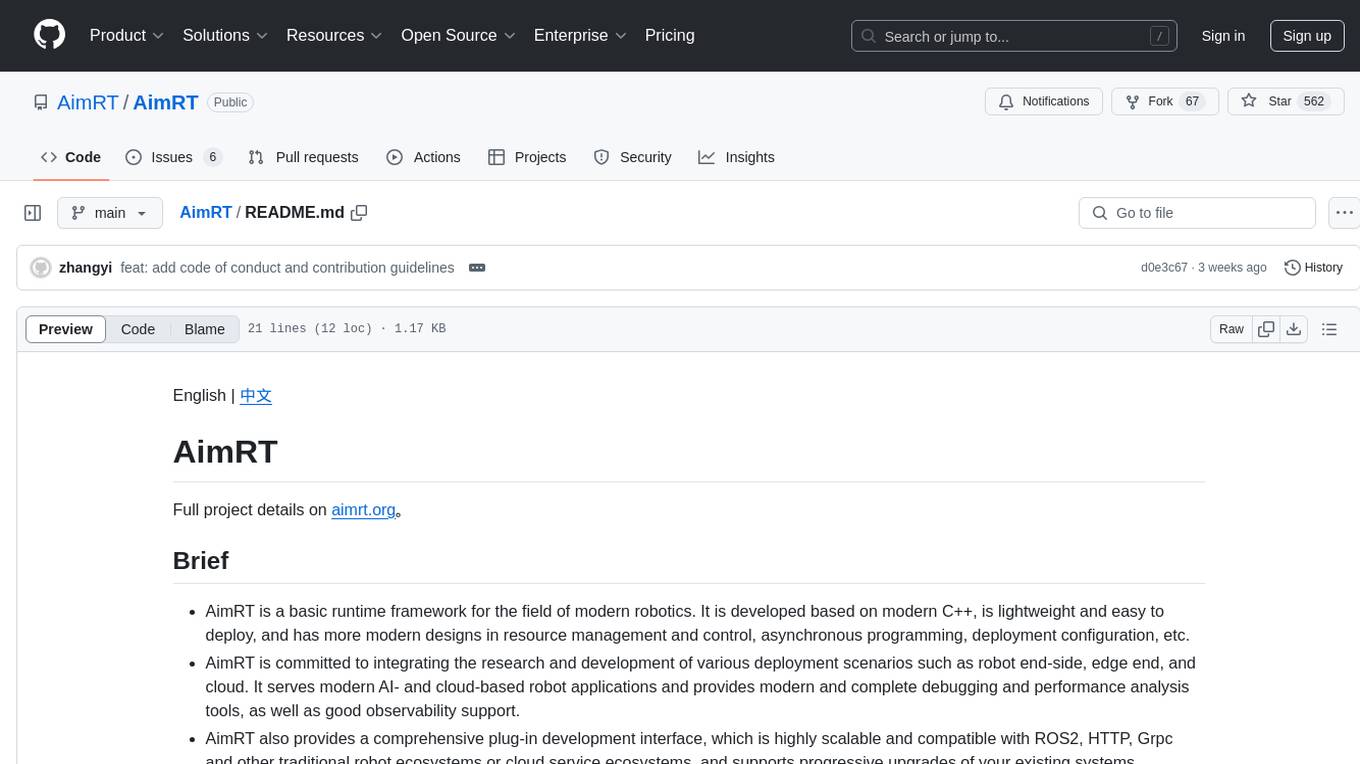
AimRT
AimRT is a basic runtime framework for modern robotics, developed in modern C++ with lightweight and easy deployment. It integrates research and development for robot applications in various deployment scenarios, providing debugging tools and observability support. AimRT offers a plug-in development interface compatible with ROS2, HTTP, Grpc, and other ecosystems for progressive system upgrades.
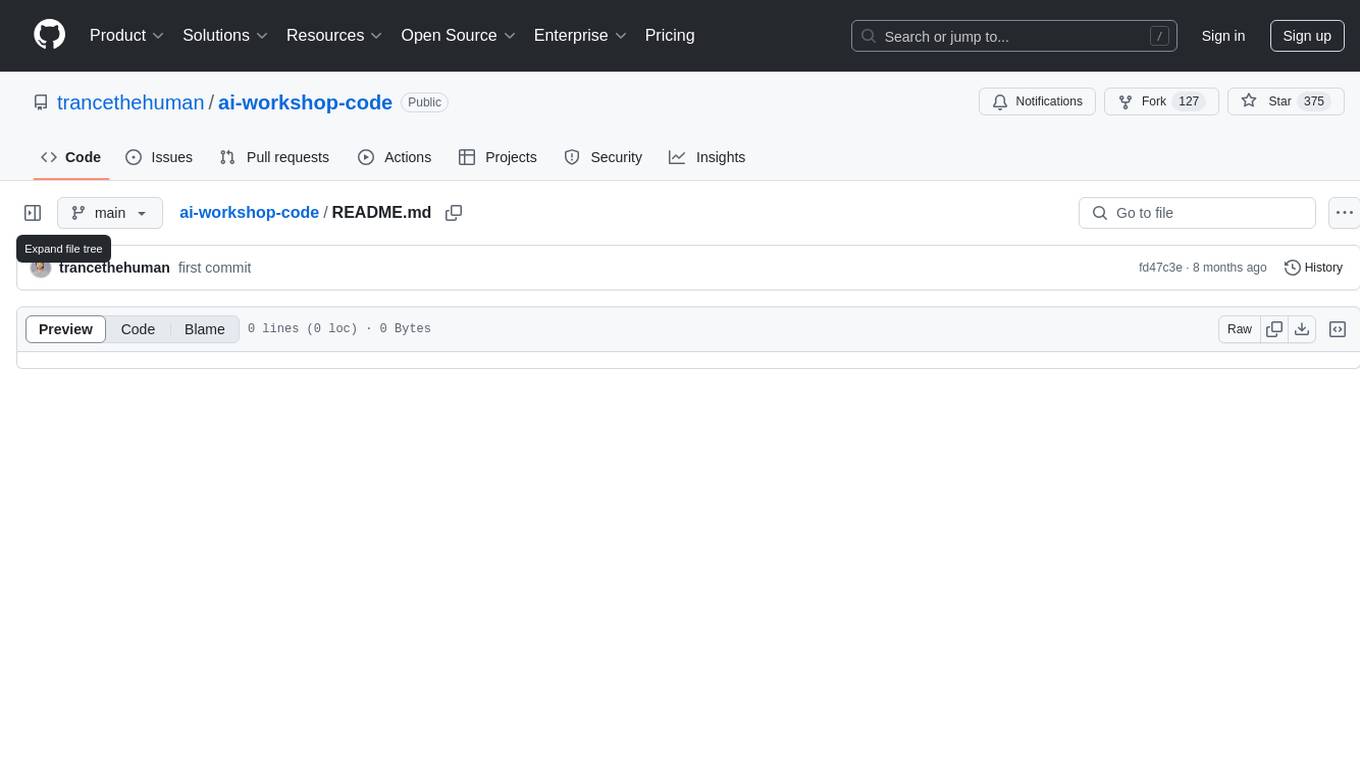
ai-workshop-code
The ai-workshop-code repository contains code examples and tutorials for various artificial intelligence concepts and algorithms. It serves as a practical resource for individuals looking to learn and implement AI techniques in their projects. The repository covers a wide range of topics, including machine learning, deep learning, natural language processing, computer vision, and reinforcement learning. By exploring the code and following the tutorials, users can gain hands-on experience with AI technologies and enhance their understanding of how these algorithms work in practice.
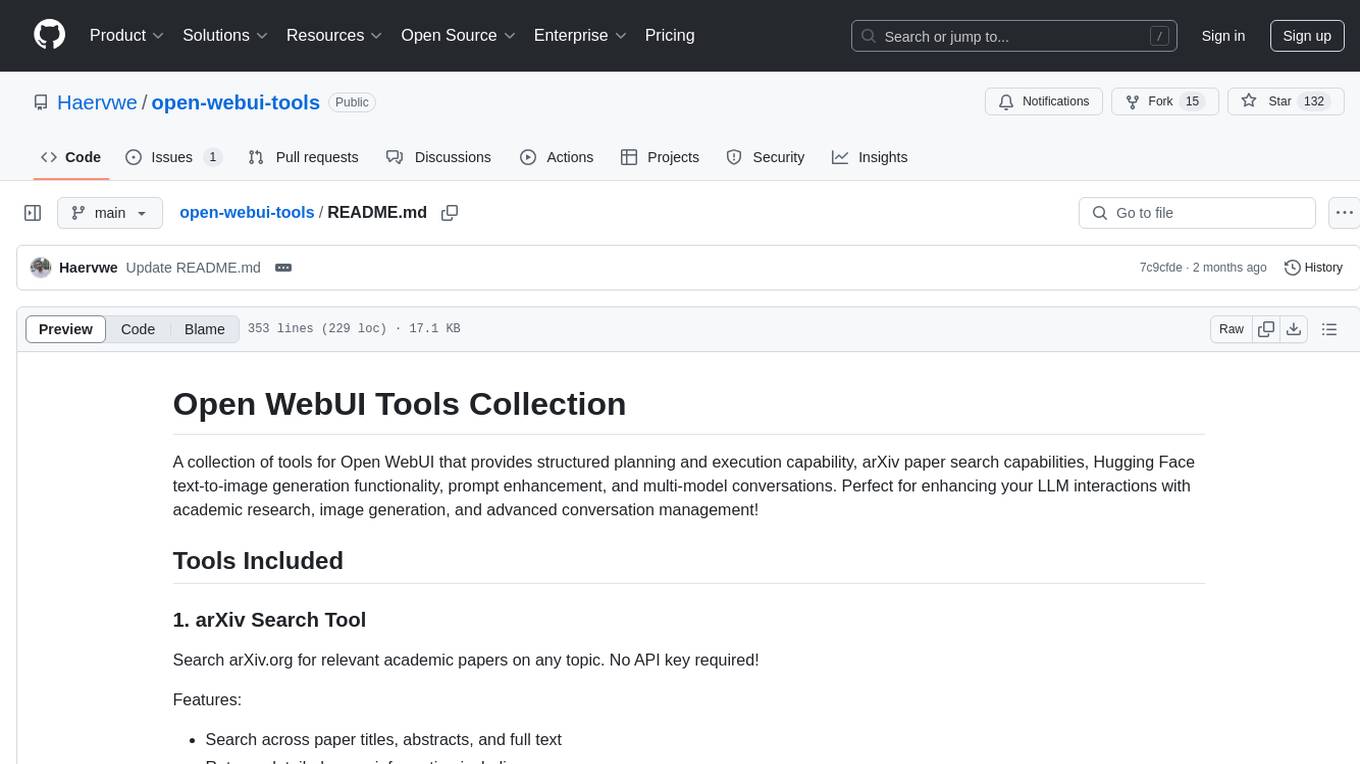
open-webui-tools
Open WebUI Tools Collection is a set of tools for structured planning, arXiv paper search, Hugging Face text-to-image generation, prompt enhancement, and multi-model conversations. It enhances LLM interactions with academic research, image generation, and conversation management. Tools include arXiv Search Tool and Hugging Face Image Generator. Function Pipes like Planner Agent offer autonomous plan generation and execution. Filters like Prompt Enhancer improve prompt quality. Installation and configuration instructions are provided for each tool and pipe.
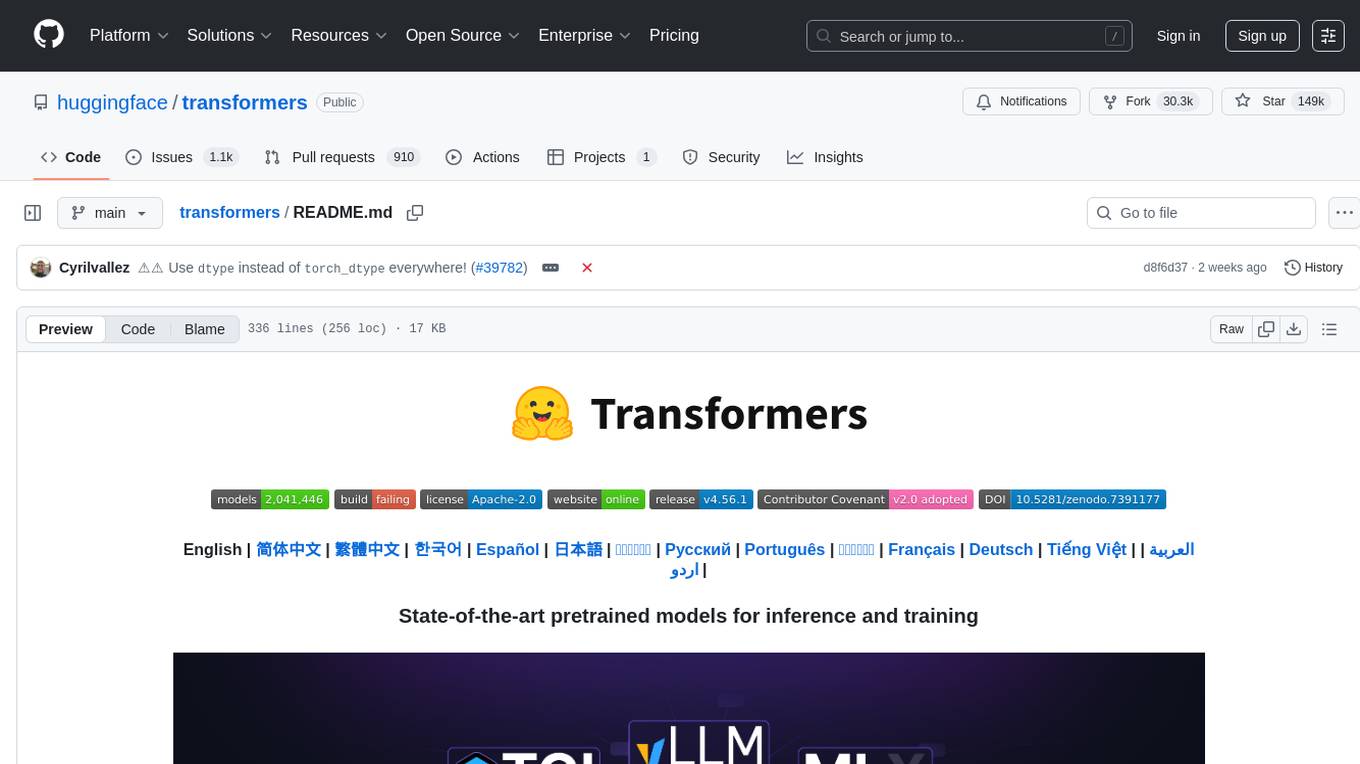
transformers
Transformers is a state-of-the-art pretrained models library that acts as the model-definition framework for machine learning models in text, computer vision, audio, video, and multimodal tasks. It centralizes model definition for compatibility across various training frameworks, inference engines, and modeling libraries. The library simplifies the usage of new models by providing simple, customizable, and efficient model definitions. With over 1M+ Transformers model checkpoints available, users can easily find and utilize models for their tasks.
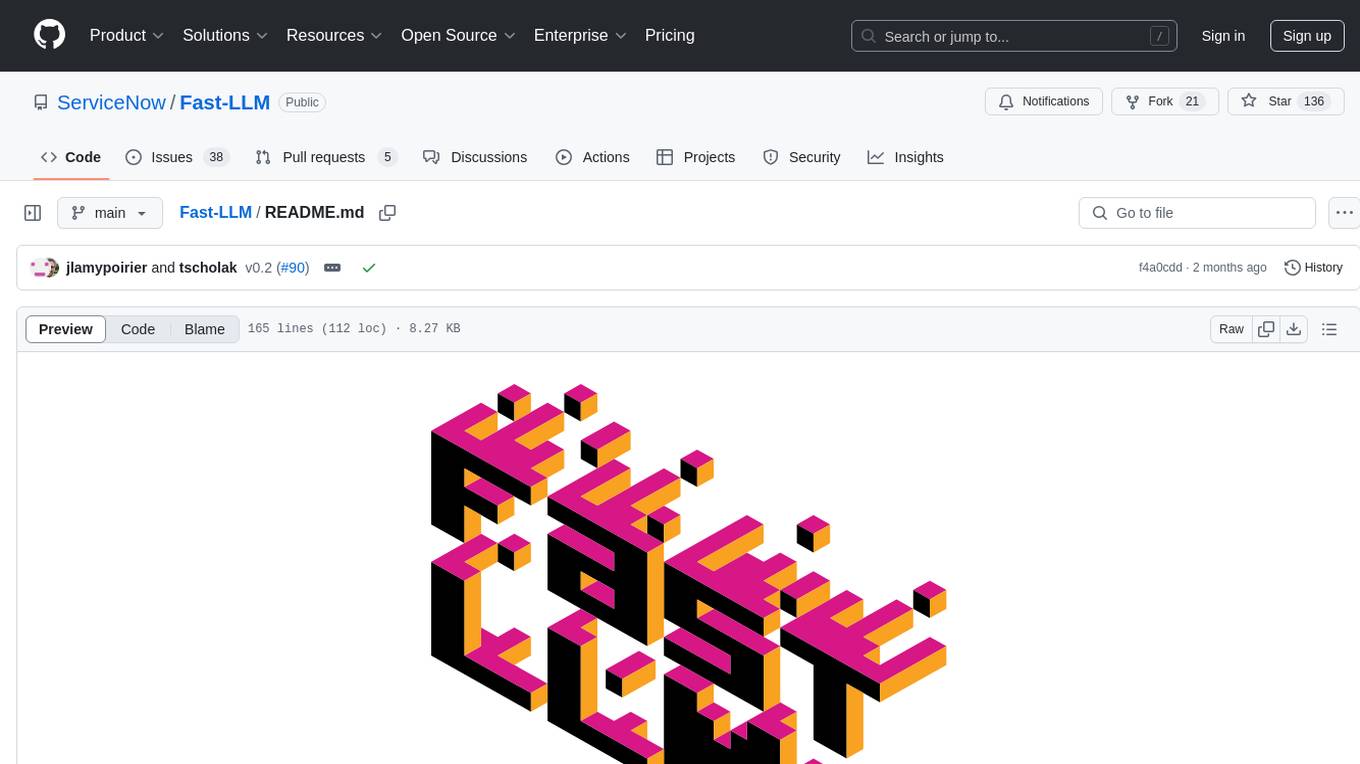
Fast-LLM
Fast-LLM is an open-source library designed for training large language models with exceptional speed, scalability, and flexibility. Built on PyTorch and Triton, it offers optimized kernel efficiency, reduced overheads, and memory usage, making it suitable for training models of all sizes. The library supports distributed training across multiple GPUs and nodes, offers flexibility in model architectures, and is easy to use with pre-built Docker images and simple configuration. Fast-LLM is licensed under Apache 2.0, developed transparently on GitHub, and encourages contributions and collaboration from the community.
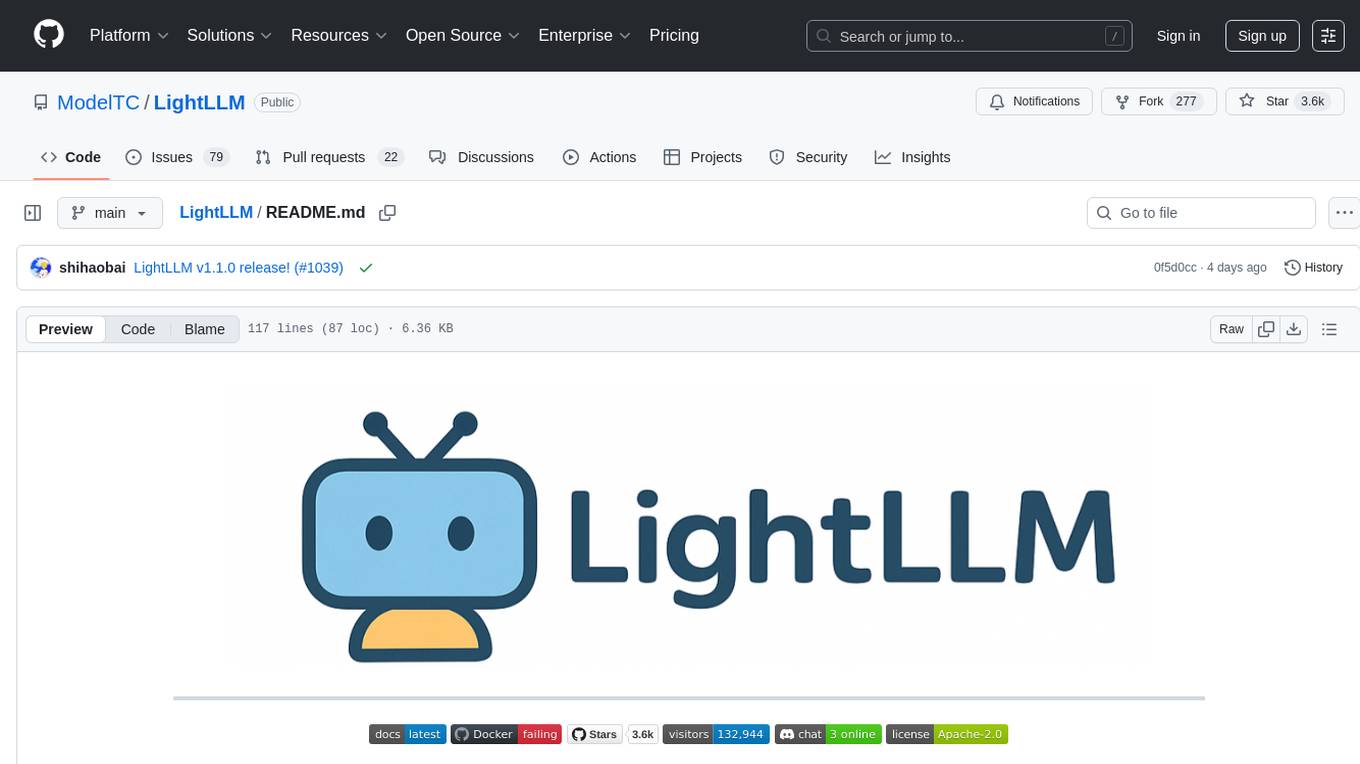
LightLLM
LightLLM is a lightweight library for linear and logistic regression models. It provides a simple and efficient way to train and deploy machine learning models for regression tasks. The library is designed to be easy to use and integrate into existing projects, making it suitable for both beginners and experienced data scientists. With LightLLM, users can quickly build and evaluate regression models using a variety of algorithms and hyperparameters. The library also supports feature engineering and model interpretation, allowing users to gain insights from their data and make informed decisions based on the model predictions.
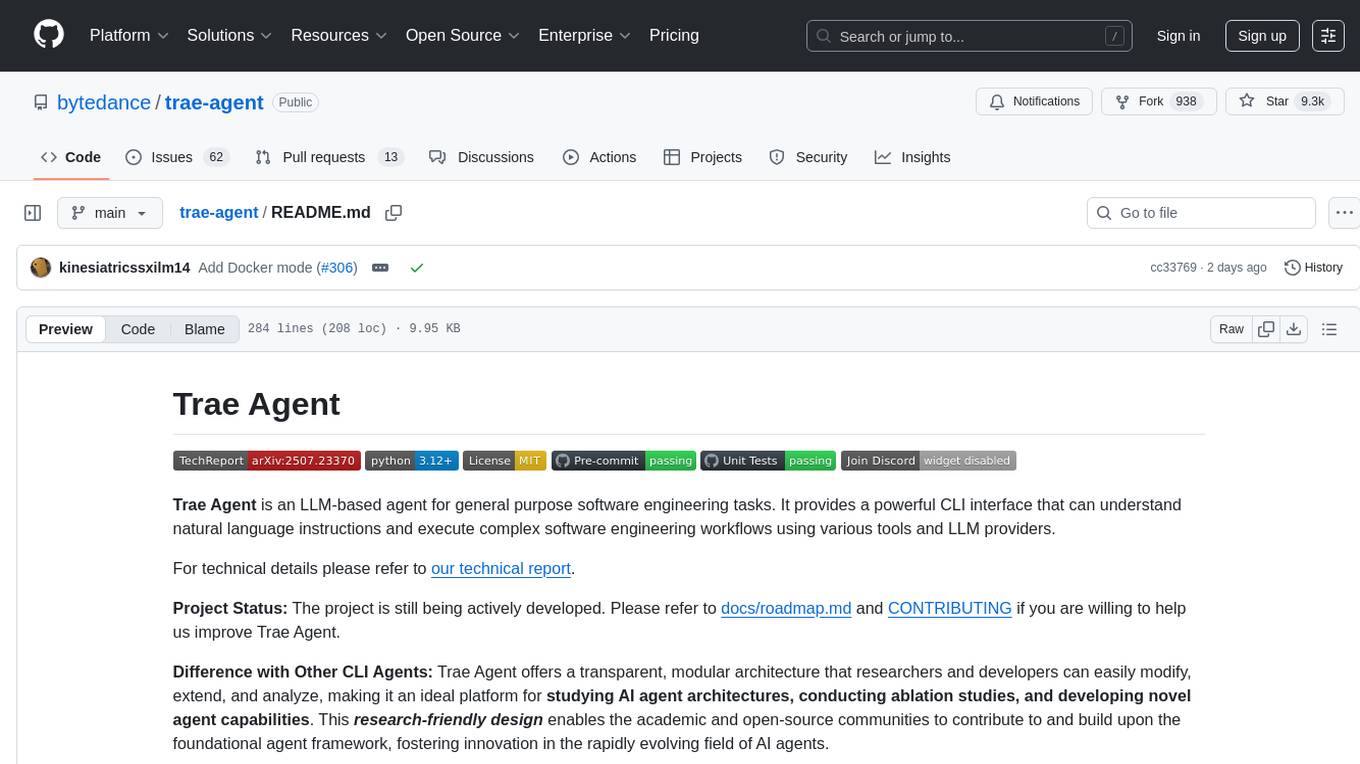
trae-agent
Trae-agent is a Python library for building and training reinforcement learning agents. It provides a simple and flexible framework for implementing various reinforcement learning algorithms and experimenting with different environments. With Trae-agent, users can easily create custom agents, define reward functions, and train them on a variety of tasks. The library also includes utilities for visualizing agent performance and analyzing training results, making it a valuable tool for both beginners and experienced researchers in the field of reinforcement learning.
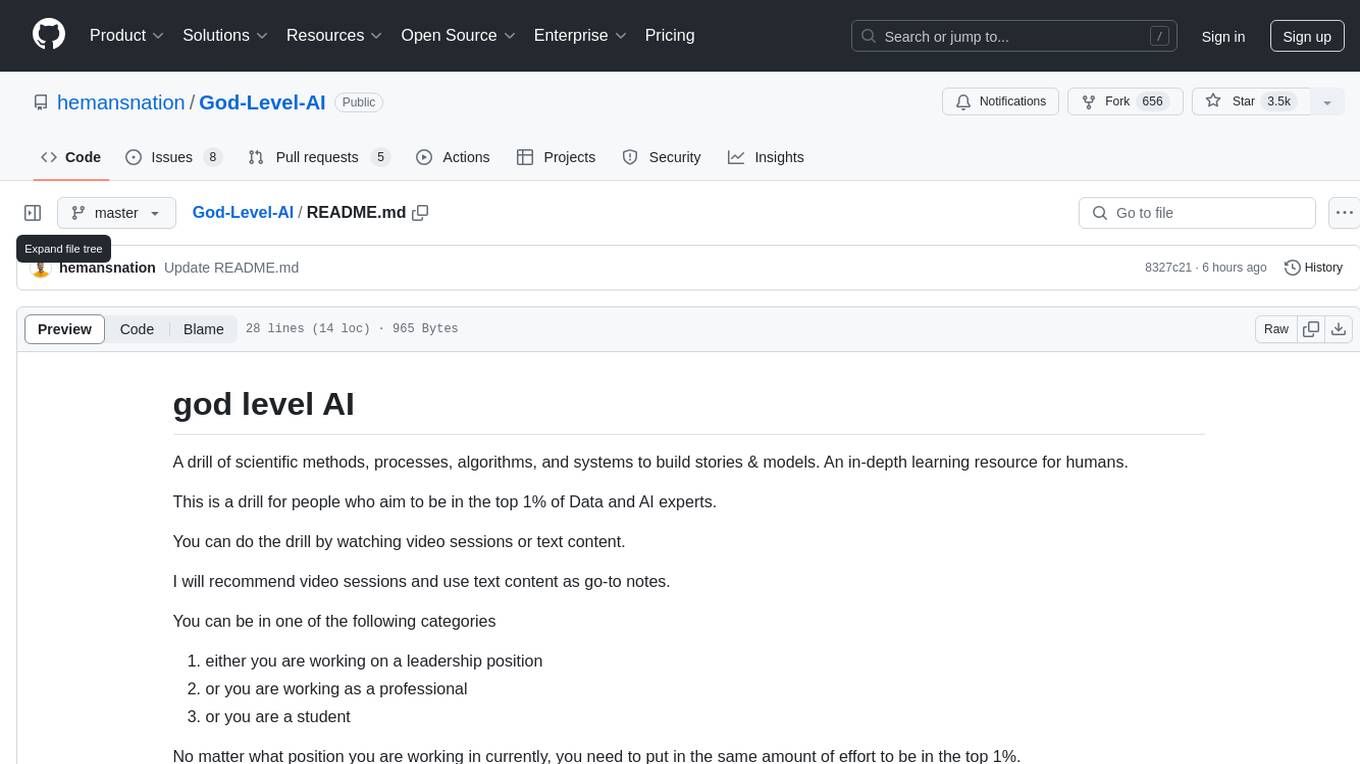
God-Level-AI
A drill of scientific methods, processes, algorithms, and systems to build stories & models. An in-depth learning resource for humans. This repository is designed for individuals aiming to excel in the field of Data and AI, providing video sessions and text content for learning. It caters to those in leadership positions, professionals, and students, emphasizing the need for dedicated effort to achieve excellence in the tech field. The content covers various topics with a focus on practical application.
For similar tasks
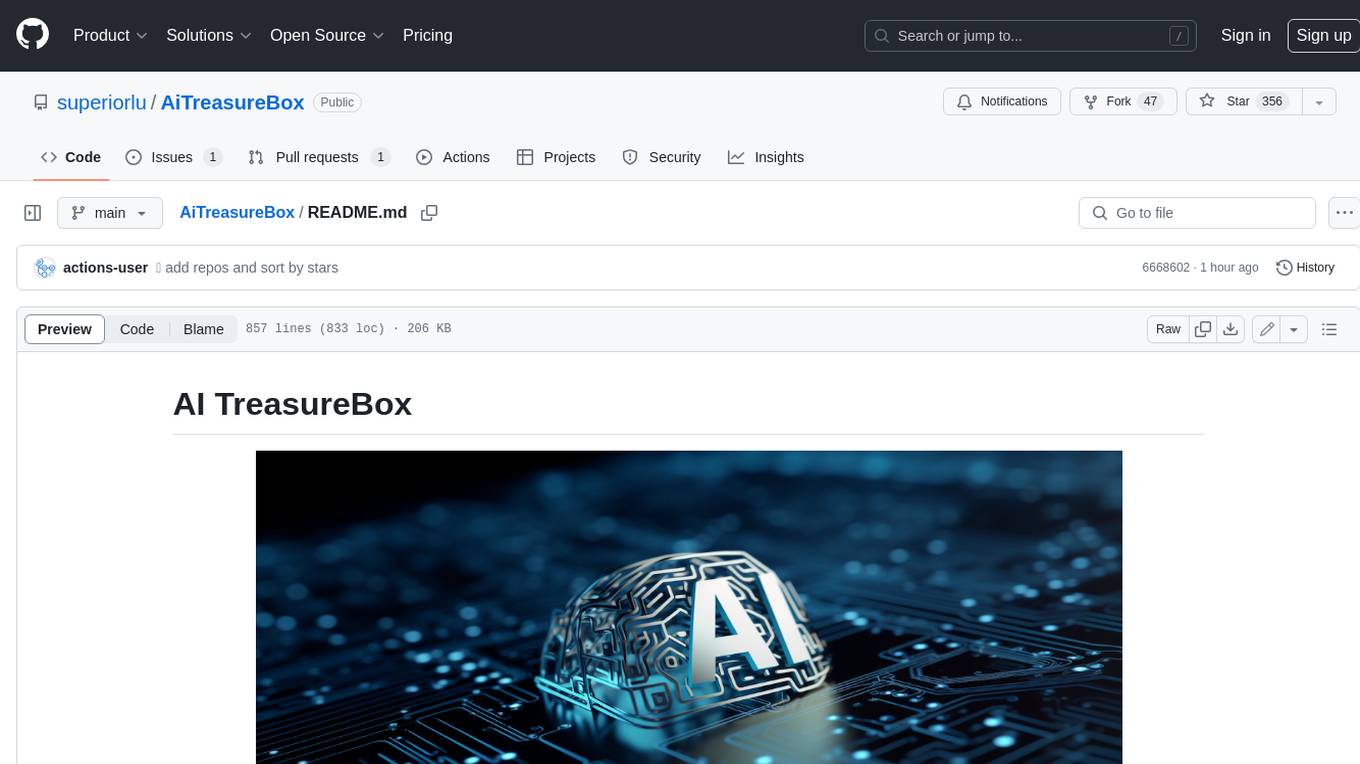
AiTreasureBox
AiTreasureBox is a versatile AI tool that provides a collection of pre-trained models and algorithms for various machine learning tasks. It simplifies the process of implementing AI solutions by offering ready-to-use components that can be easily integrated into projects. With AiTreasureBox, users can quickly prototype and deploy AI applications without the need for extensive knowledge in machine learning or deep learning. The tool covers a wide range of tasks such as image classification, text generation, sentiment analysis, object detection, and more. It is designed to be user-friendly and accessible to both beginners and experienced developers, making AI development more efficient and accessible to a wider audience.
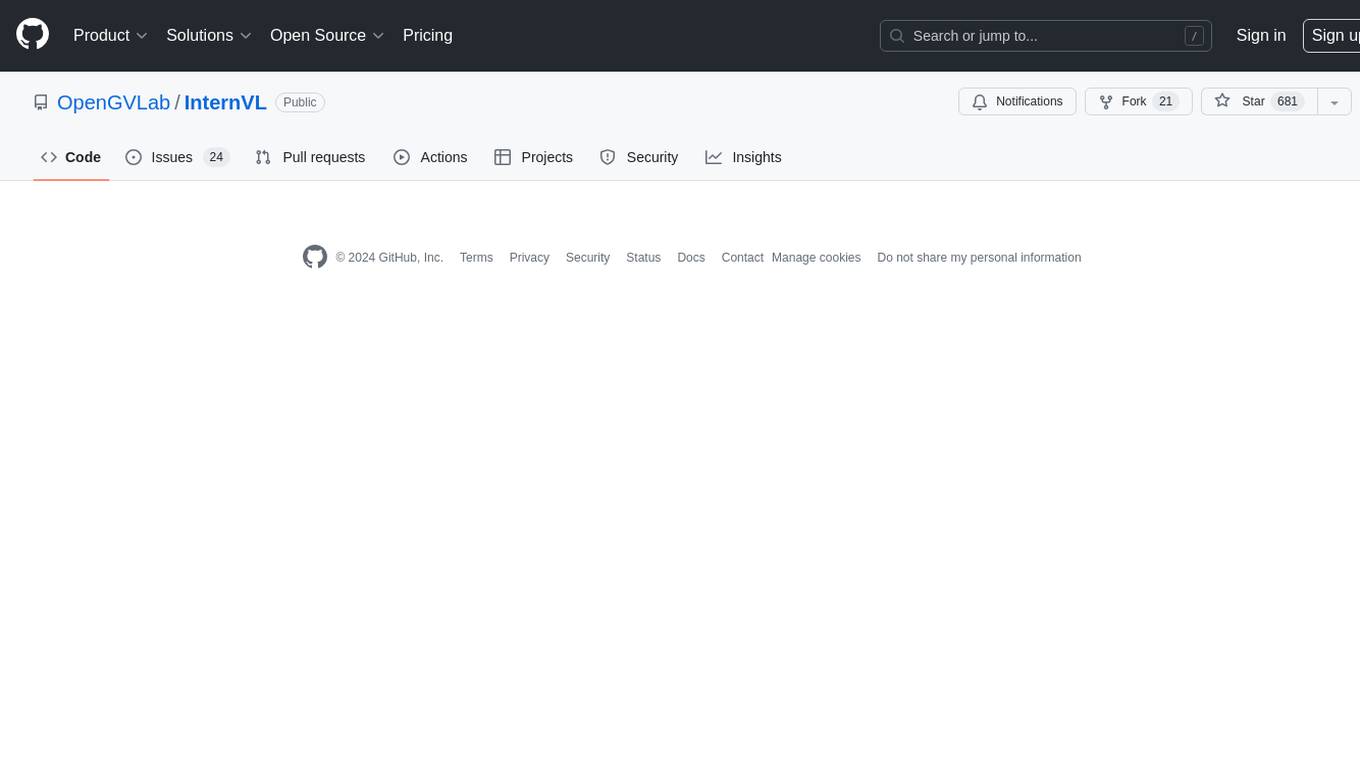
InternVL
InternVL scales up the ViT to _**6B parameters**_ and aligns it with LLM. It is a vision-language foundation model that can perform various tasks, including: **Visual Perception** - Linear-Probe Image Classification - Semantic Segmentation - Zero-Shot Image Classification - Multilingual Zero-Shot Image Classification - Zero-Shot Video Classification **Cross-Modal Retrieval** - English Zero-Shot Image-Text Retrieval - Chinese Zero-Shot Image-Text Retrieval - Multilingual Zero-Shot Image-Text Retrieval on XTD **Multimodal Dialogue** - Zero-Shot Image Captioning - Multimodal Benchmarks with Frozen LLM - Multimodal Benchmarks with Trainable LLM - Tiny LVLM InternVL has been shown to achieve state-of-the-art results on a variety of benchmarks. For example, on the MMMU image classification benchmark, InternVL achieves a top-1 accuracy of 51.6%, which is higher than GPT-4V and Gemini Pro. On the DocVQA question answering benchmark, InternVL achieves a score of 82.2%, which is also higher than GPT-4V and Gemini Pro. InternVL is open-sourced and available on Hugging Face. It can be used for a variety of applications, including image classification, object detection, semantic segmentation, image captioning, and question answering.
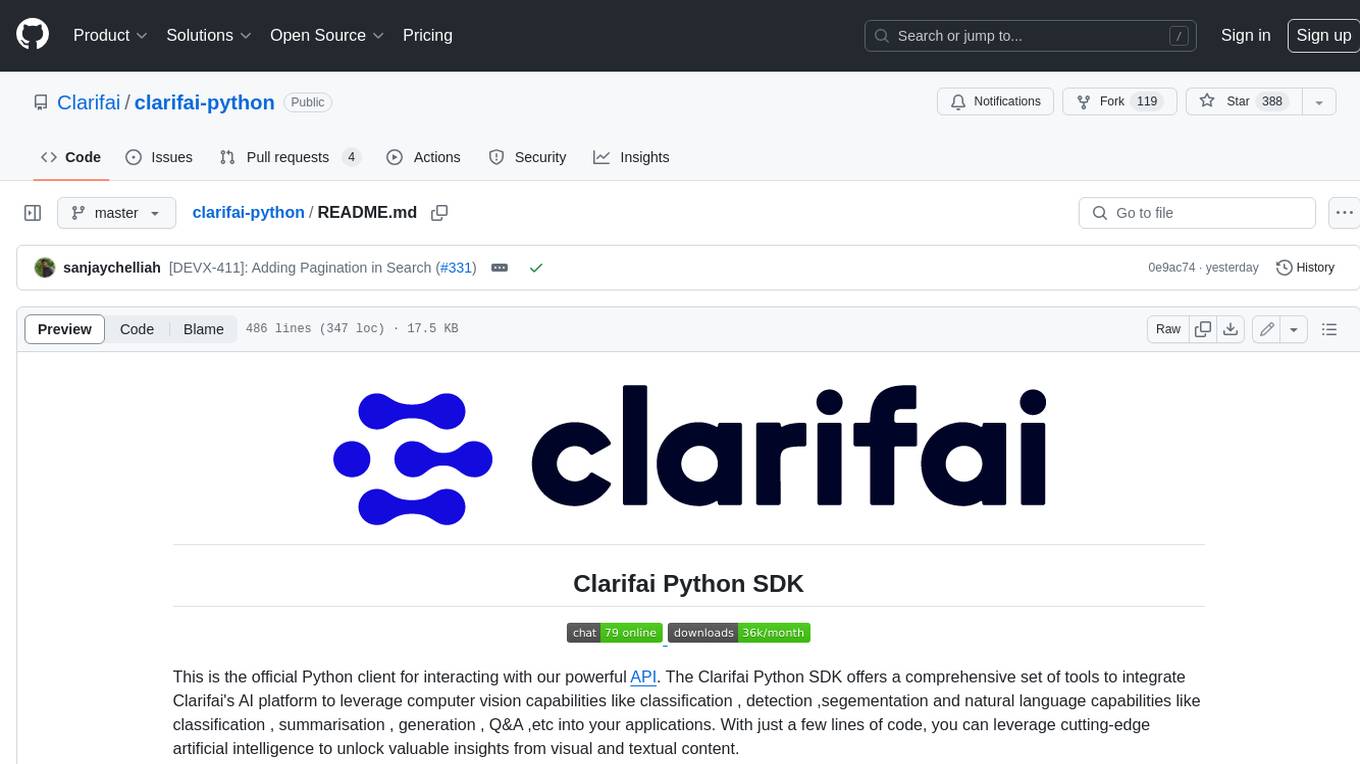
clarifai-python
The Clarifai Python SDK offers a comprehensive set of tools to integrate Clarifai's AI platform to leverage computer vision capabilities like classification , detection ,segementation and natural language capabilities like classification , summarisation , generation , Q&A ,etc into your applications. With just a few lines of code, you can leverage cutting-edge artificial intelligence to unlock valuable insights from visual and textual content.
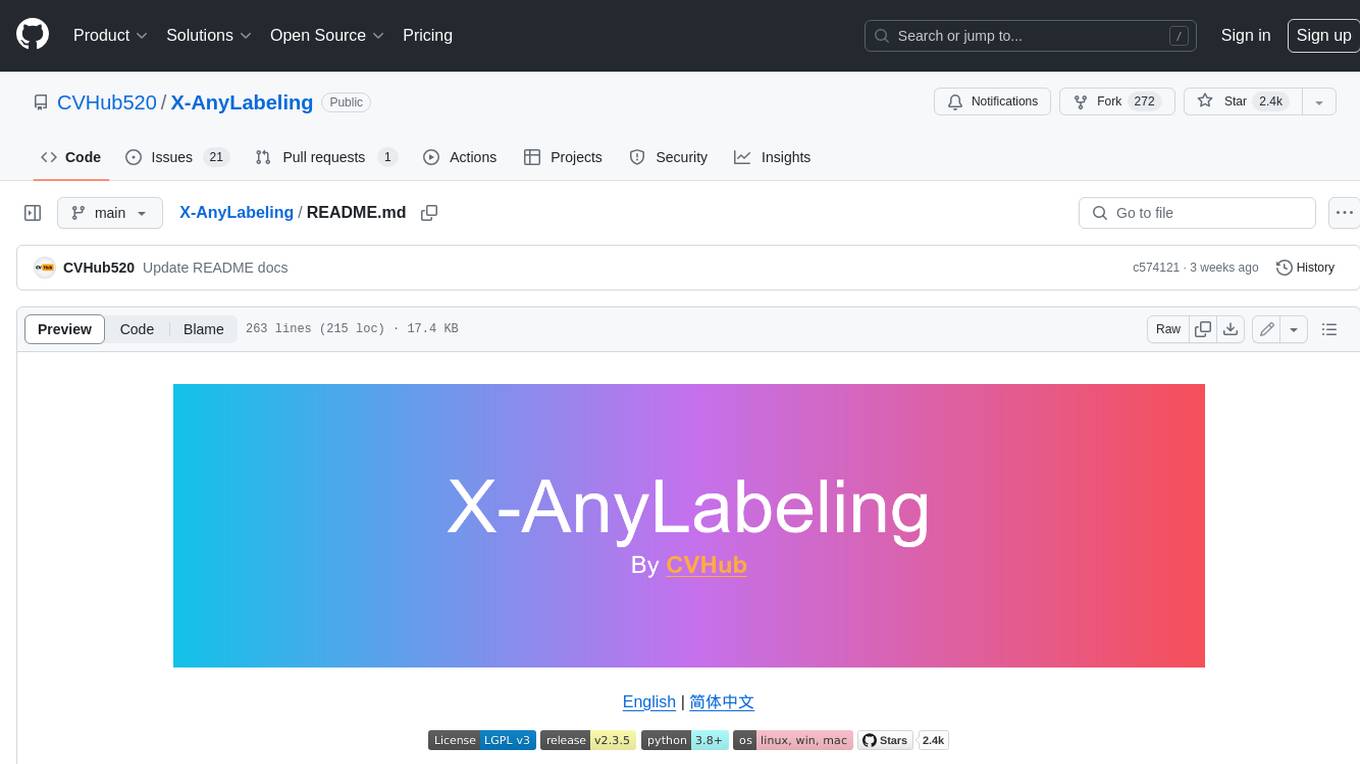
X-AnyLabeling
X-AnyLabeling is a robust annotation tool that seamlessly incorporates an AI inference engine alongside an array of sophisticated features. Tailored for practical applications, it is committed to delivering comprehensive, industrial-grade solutions for image data engineers. This tool excels in swiftly and automatically executing annotations across diverse and intricate tasks.
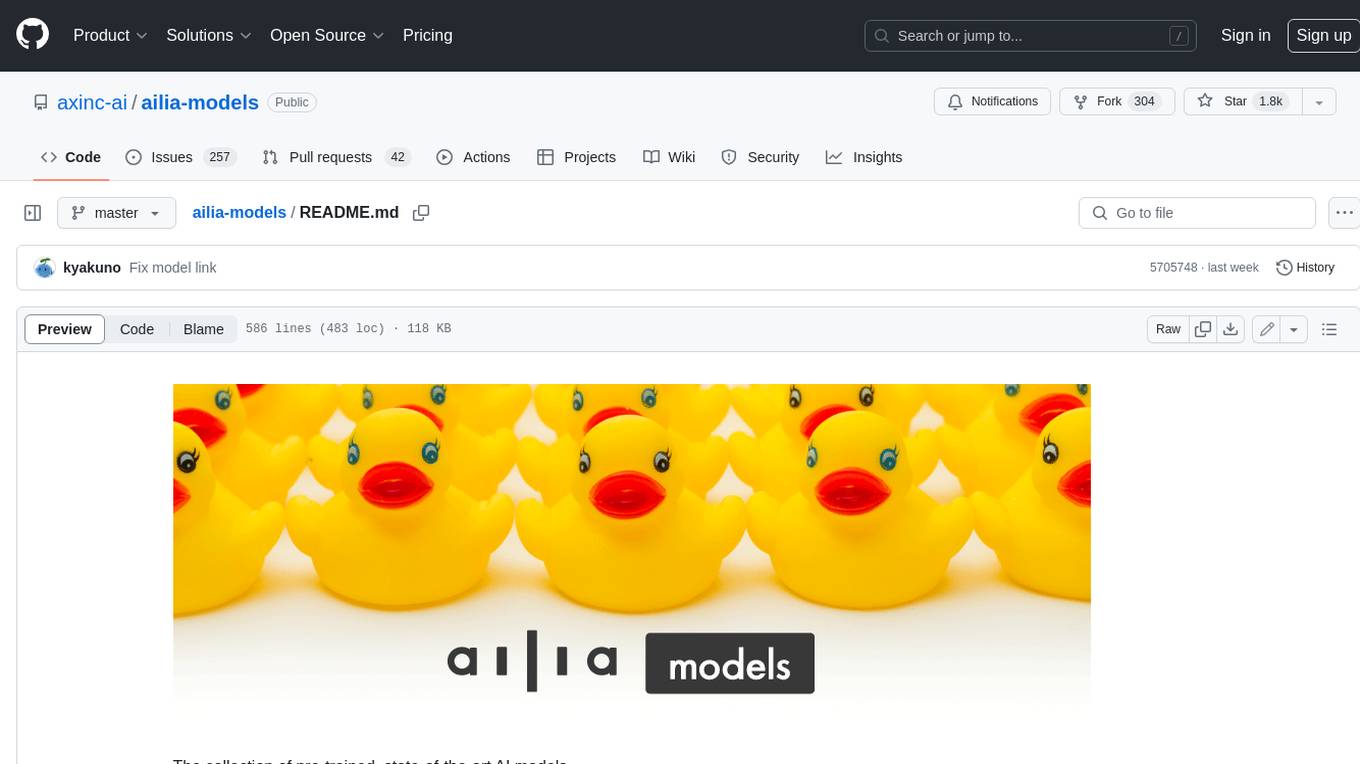
ailia-models
The collection of pre-trained, state-of-the-art AI models. ailia SDK is a self-contained, cross-platform, high-speed inference SDK for AI. The ailia SDK provides a consistent C++ API across Windows, Mac, Linux, iOS, Android, Jetson, and Raspberry Pi platforms. It also supports Unity (C#), Python, Rust, Flutter(Dart) and JNI for efficient AI implementation. The ailia SDK makes extensive use of the GPU through Vulkan and Metal to enable accelerated computing. # Supported models 323 models as of April 8th, 2024
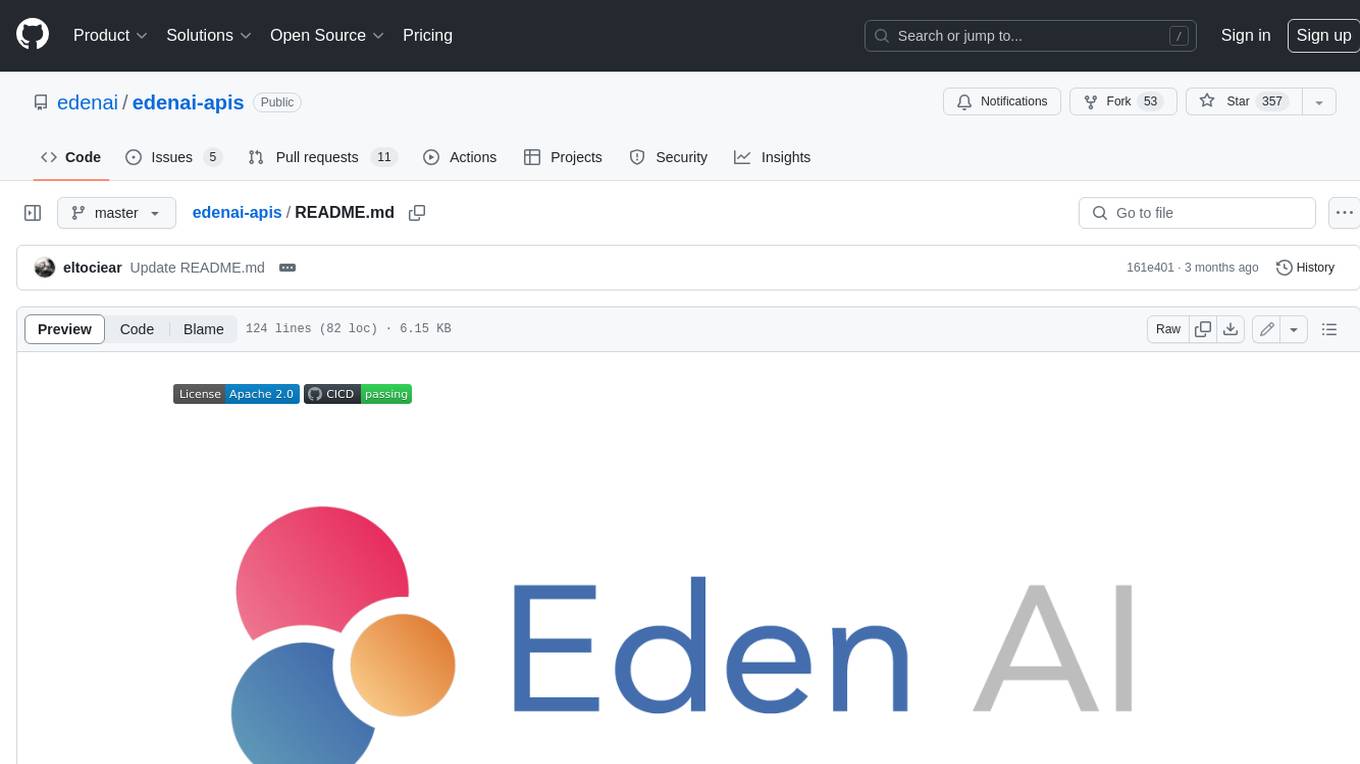
edenai-apis
Eden AI aims to simplify the use and deployment of AI technologies by providing a unique API that connects to all the best AI engines. With the rise of **AI as a Service** , a lot of companies provide off-the-shelf trained models that you can access directly through an API. These companies are either the tech giants (Google, Microsoft , Amazon) or other smaller, more specialized companies, and there are hundreds of them. Some of the most known are : DeepL (translation), OpenAI (text and image analysis), AssemblyAI (speech analysis). There are **hundreds of companies** doing that. We're regrouping the best ones **in one place** !
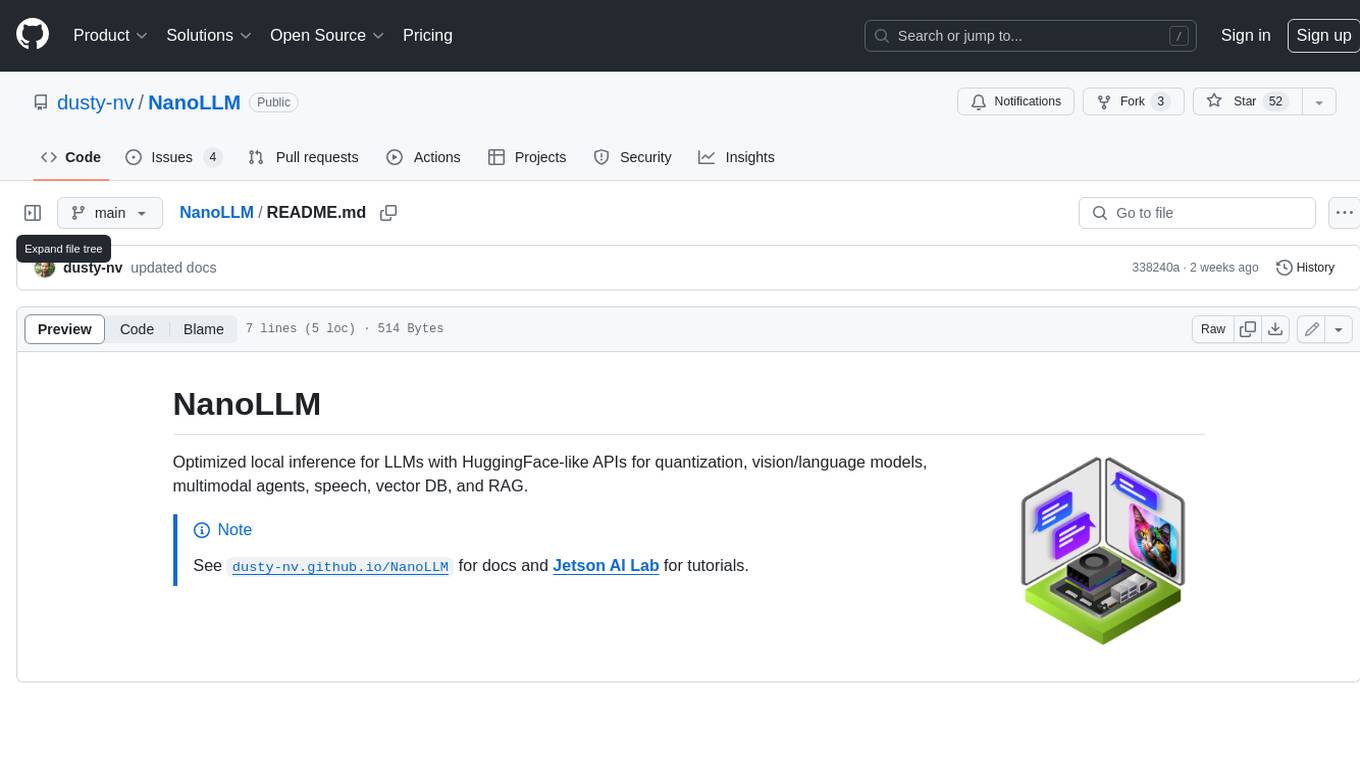
NanoLLM
NanoLLM is a tool designed for optimized local inference for Large Language Models (LLMs) using HuggingFace-like APIs. It supports quantization, vision/language models, multimodal agents, speech, vector DB, and RAG. The tool aims to provide efficient and effective processing for LLMs on local devices, enhancing performance and usability for various AI applications.
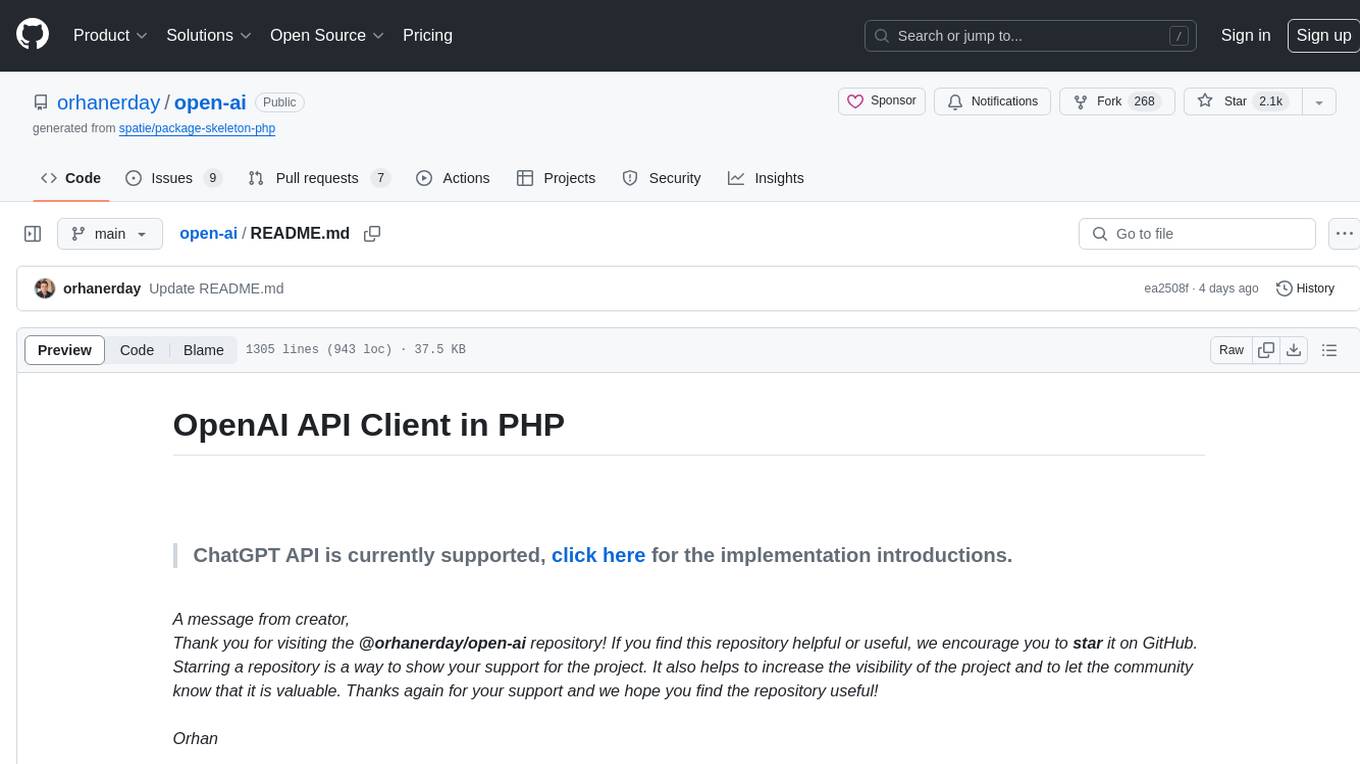
open-ai
Open AI is a powerful tool for artificial intelligence research and development. It provides a wide range of machine learning models and algorithms, making it easier for developers to create innovative AI applications. With Open AI, users can explore cutting-edge technologies such as natural language processing, computer vision, and reinforcement learning. The platform offers a user-friendly interface and comprehensive documentation to support users in building and deploying AI solutions. Whether you are a beginner or an experienced AI practitioner, Open AI offers the tools and resources you need to accelerate your AI projects and stay ahead in the rapidly evolving field of artificial intelligence.
For similar jobs
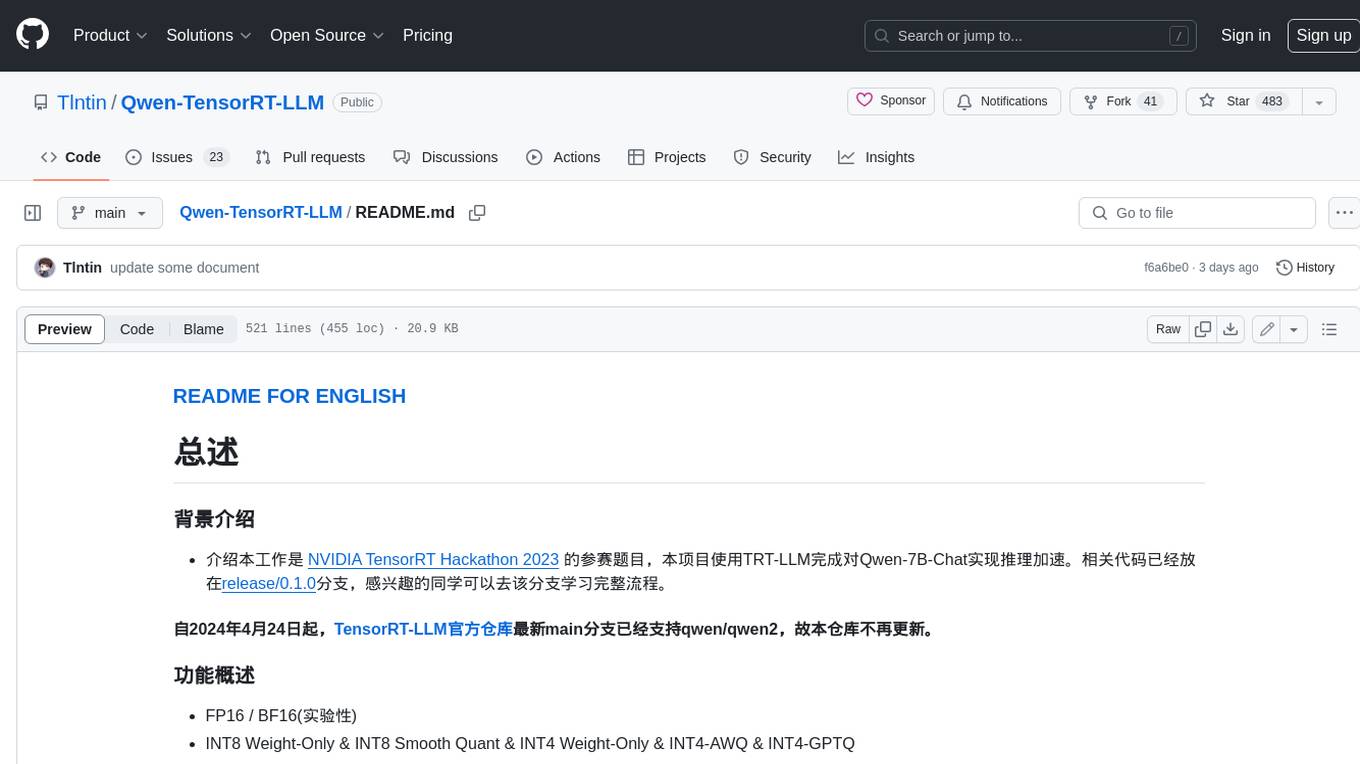
Qwen-TensorRT-LLM
Qwen-TensorRT-LLM is a project developed for the NVIDIA TensorRT Hackathon 2023, focusing on accelerating inference for the Qwen-7B-Chat model using TRT-LLM. The project offers various functionalities such as FP16/BF16 support, INT8 and INT4 quantization options, Tensor Parallel for multi-GPU parallelism, web demo setup with gradio, Triton API deployment for maximum throughput/concurrency, fastapi integration for openai requests, CLI interaction, and langchain support. It supports models like qwen2, qwen, and qwen-vl for both base and chat models. The project also provides tutorials on Bilibili and blogs for adapting Qwen models in NVIDIA TensorRT-LLM, along with hardware requirements and quick start guides for different model types and quantization methods.
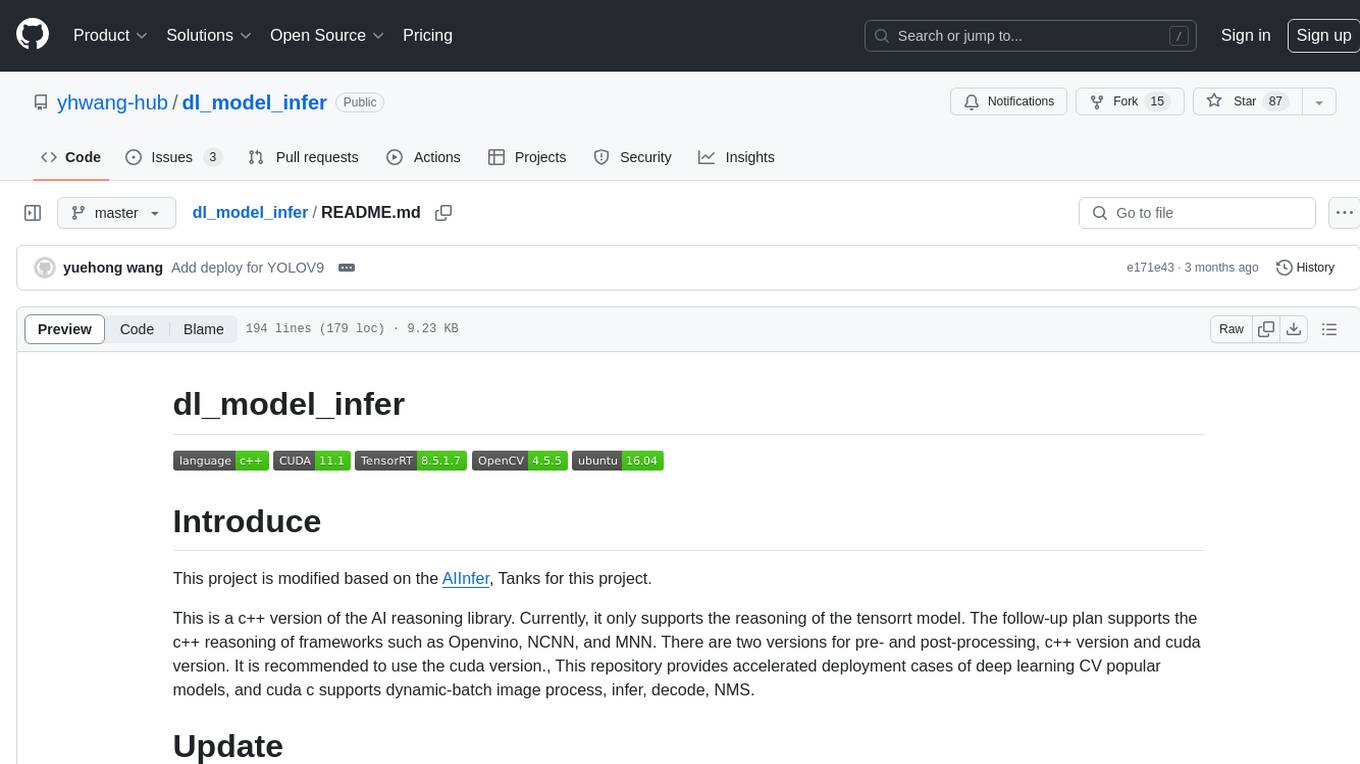
dl_model_infer
This project is a c++ version of the AI reasoning library that supports the reasoning of tensorrt models. It provides accelerated deployment cases of deep learning CV popular models and supports dynamic-batch image processing, inference, decode, and NMS. The project has been updated with various models and provides tutorials for model exports. It also includes a producer-consumer inference model for specific tasks. The project directory includes implementations for model inference applications, backend reasoning classes, post-processing, pre-processing, and target detection and tracking. Speed tests have been conducted on various models, and onnx downloads are available for different models.
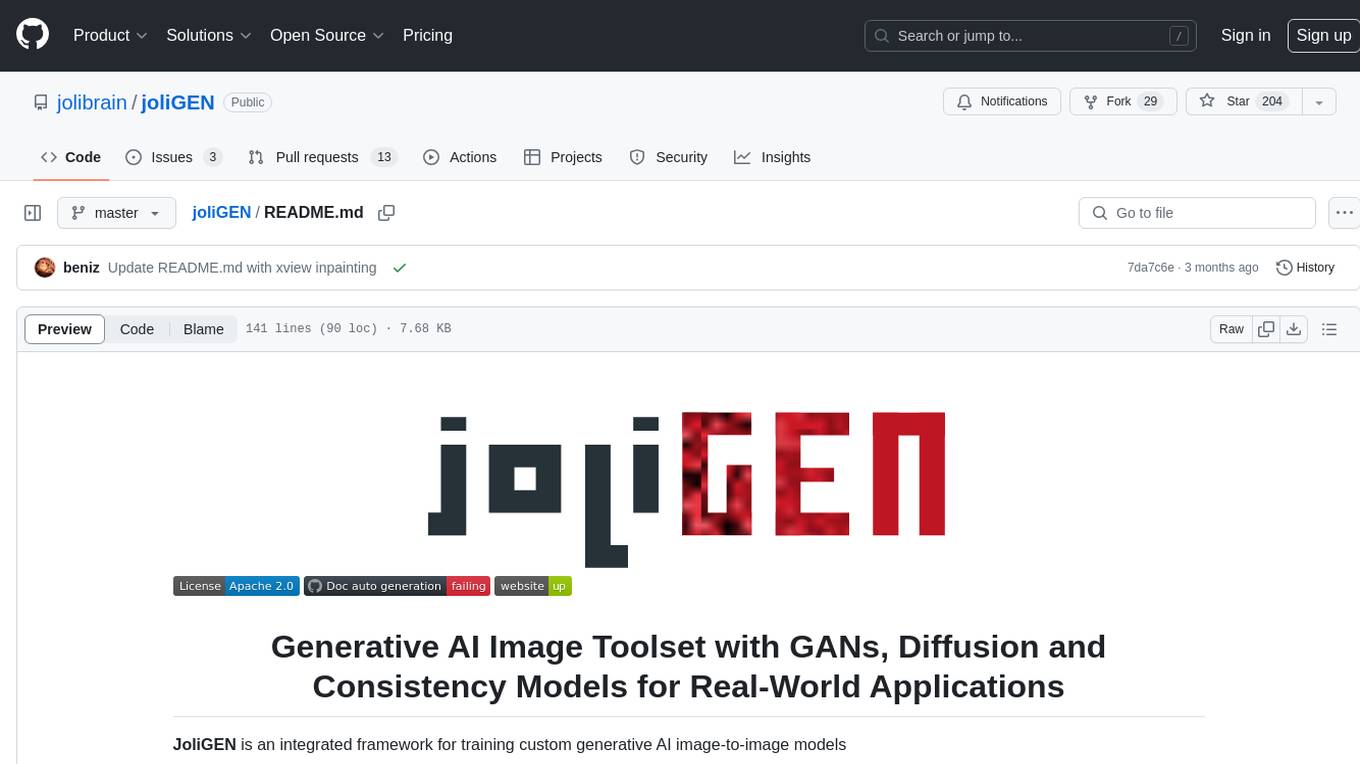
joliGEN
JoliGEN is an integrated framework for training custom generative AI image-to-image models. It implements GAN, Diffusion, and Consistency models for various image translation tasks, including domain and style adaptation with conservation of semantics. The tool is designed for real-world applications such as Controlled Image Generation, Augmented Reality, Dataset Smart Augmentation, and Synthetic to Real transforms. JoliGEN allows for fast and stable training with a REST API server for simplified deployment. It offers a wide range of options and parameters with detailed documentation available for models, dataset formats, and data augmentation.
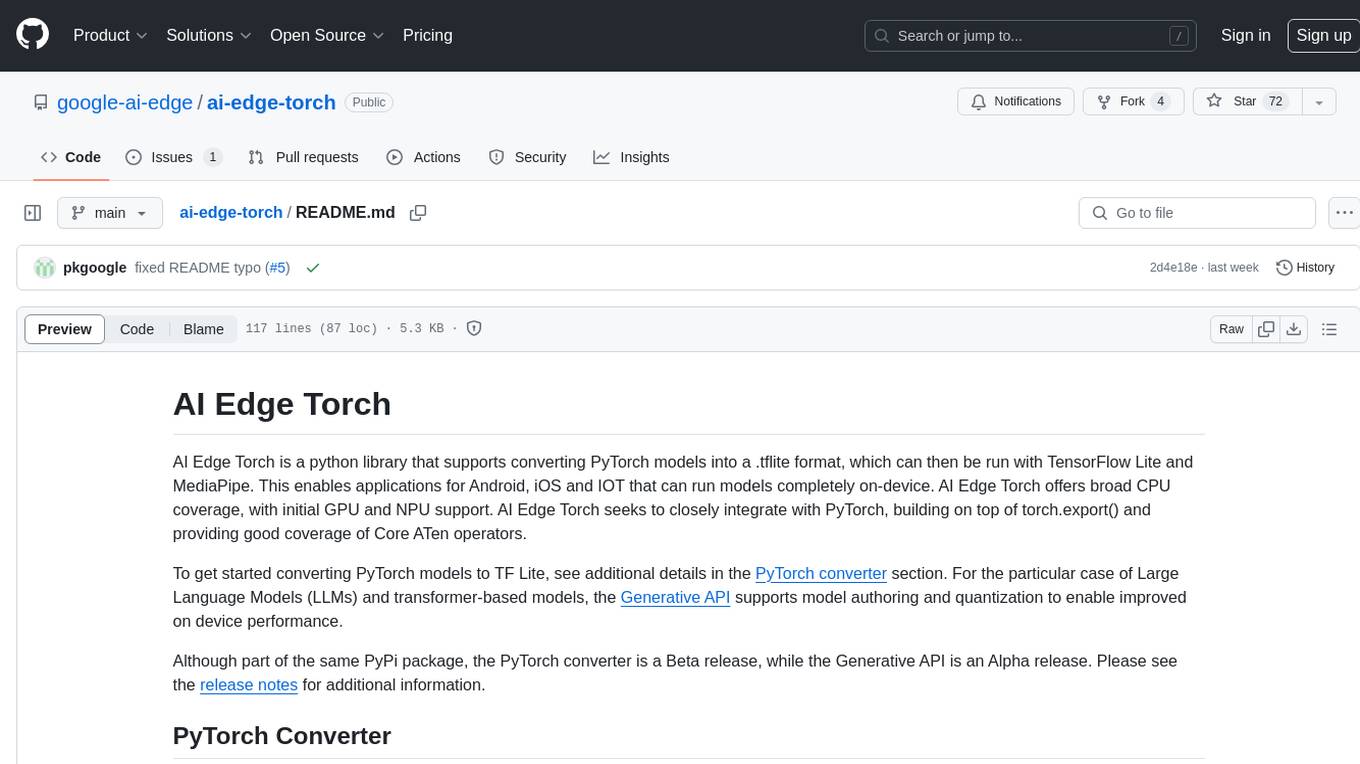
ai-edge-torch
AI Edge Torch is a Python library that supports converting PyTorch models into a .tflite format for on-device applications on Android, iOS, and IoT devices. It offers broad CPU coverage with initial GPU and NPU support, closely integrating with PyTorch and providing good coverage of Core ATen operators. The library includes a PyTorch converter for model conversion and a Generative API for authoring mobile-optimized PyTorch Transformer models, enabling easy deployment of Large Language Models (LLMs) on mobile devices.
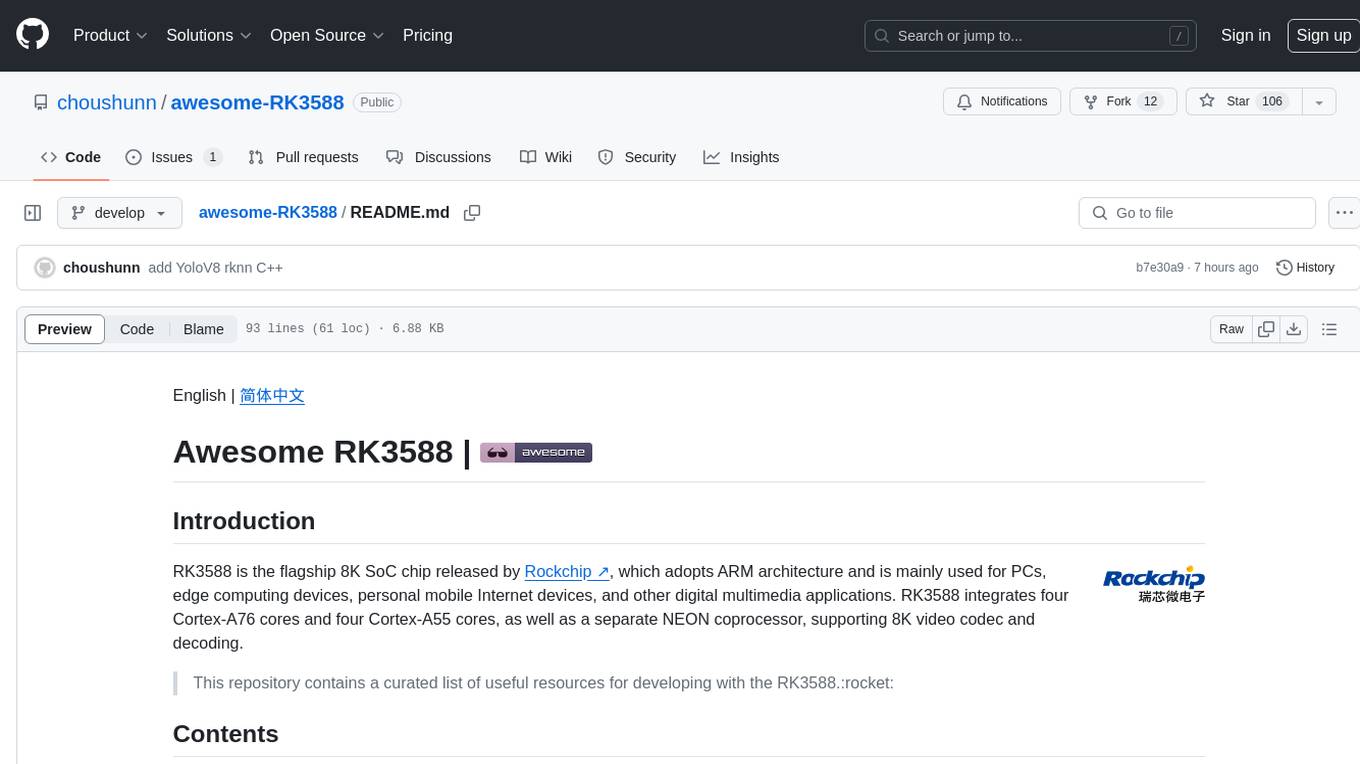
awesome-RK3588
RK3588 is a flagship 8K SoC chip by Rockchip, integrating Cortex-A76 and Cortex-A55 cores with NEON coprocessor for 8K video codec. This repository curates resources for developing with RK3588, including official resources, RKNN models, projects, development boards, documentation, tools, and sample code.
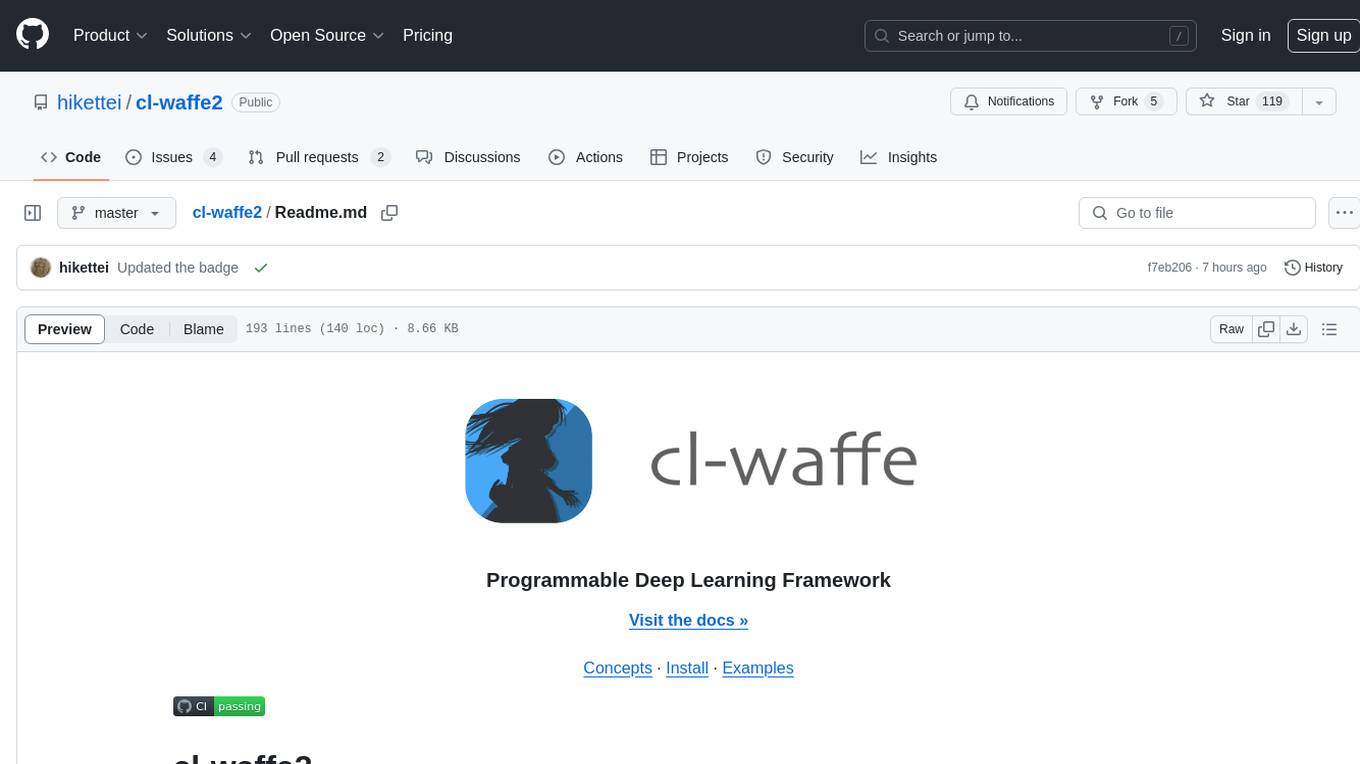
cl-waffe2
cl-waffe2 is an experimental deep learning framework in Common Lisp, providing fast, systematic, and customizable matrix operations, reverse mode tape-based Automatic Differentiation, and neural network model building and training features accelerated by a JIT Compiler. It offers abstraction layers, extensibility, inlining, graph-level optimization, visualization, debugging, systematic nodes, and symbolic differentiation. Users can easily write extensions and optimize their networks without overheads. The framework is designed to eliminate barriers between users and developers, allowing for easy customization and extension.
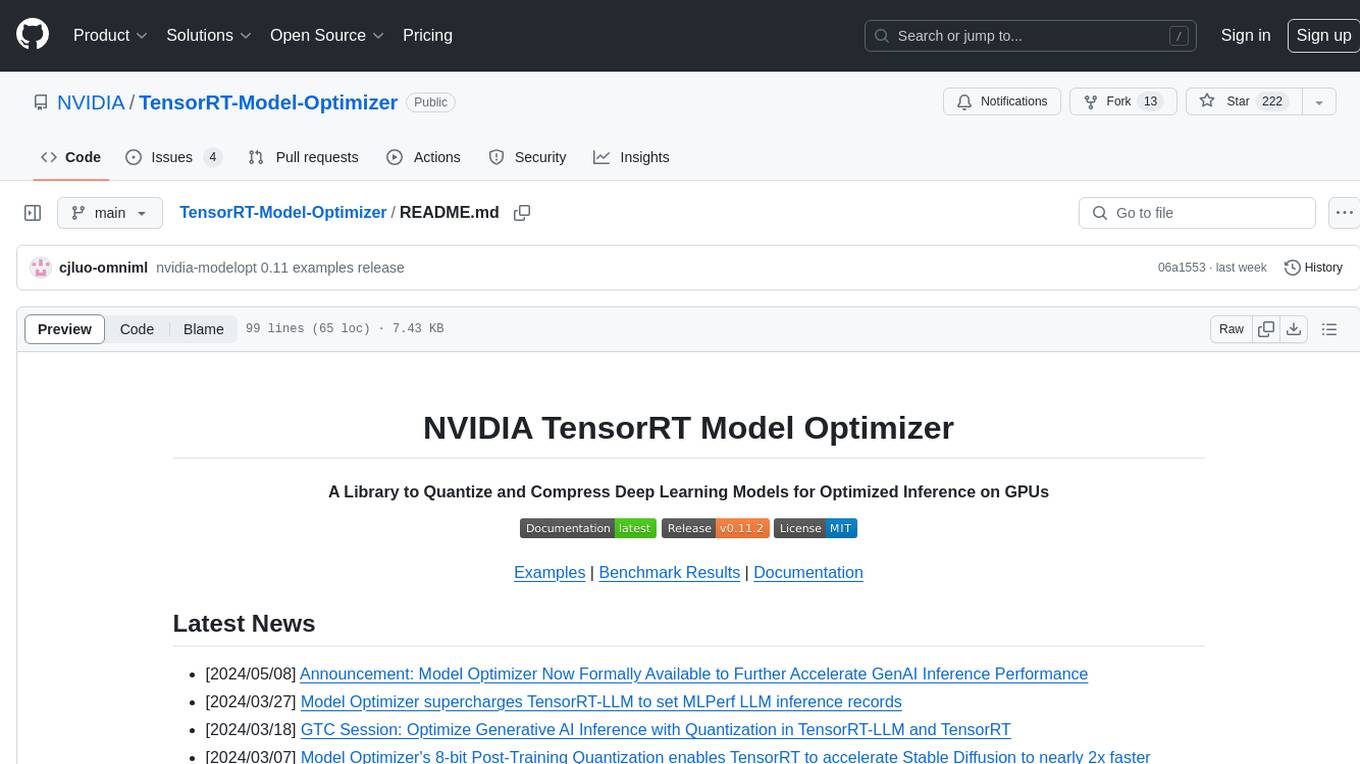
TensorRT-Model-Optimizer
The NVIDIA TensorRT Model Optimizer is a library designed to quantize and compress deep learning models for optimized inference on GPUs. It offers state-of-the-art model optimization techniques including quantization and sparsity to reduce inference costs for generative AI models. Users can easily stack different optimization techniques to produce quantized checkpoints from torch or ONNX models. The quantized checkpoints are ready for deployment in inference frameworks like TensorRT-LLM or TensorRT, with planned integrations for NVIDIA NeMo and Megatron-LM. The tool also supports 8-bit quantization with Stable Diffusion for enterprise users on NVIDIA NIM. Model Optimizer is available for free on NVIDIA PyPI, and this repository serves as a platform for sharing examples, GPU-optimized recipes, and collecting community feedback.
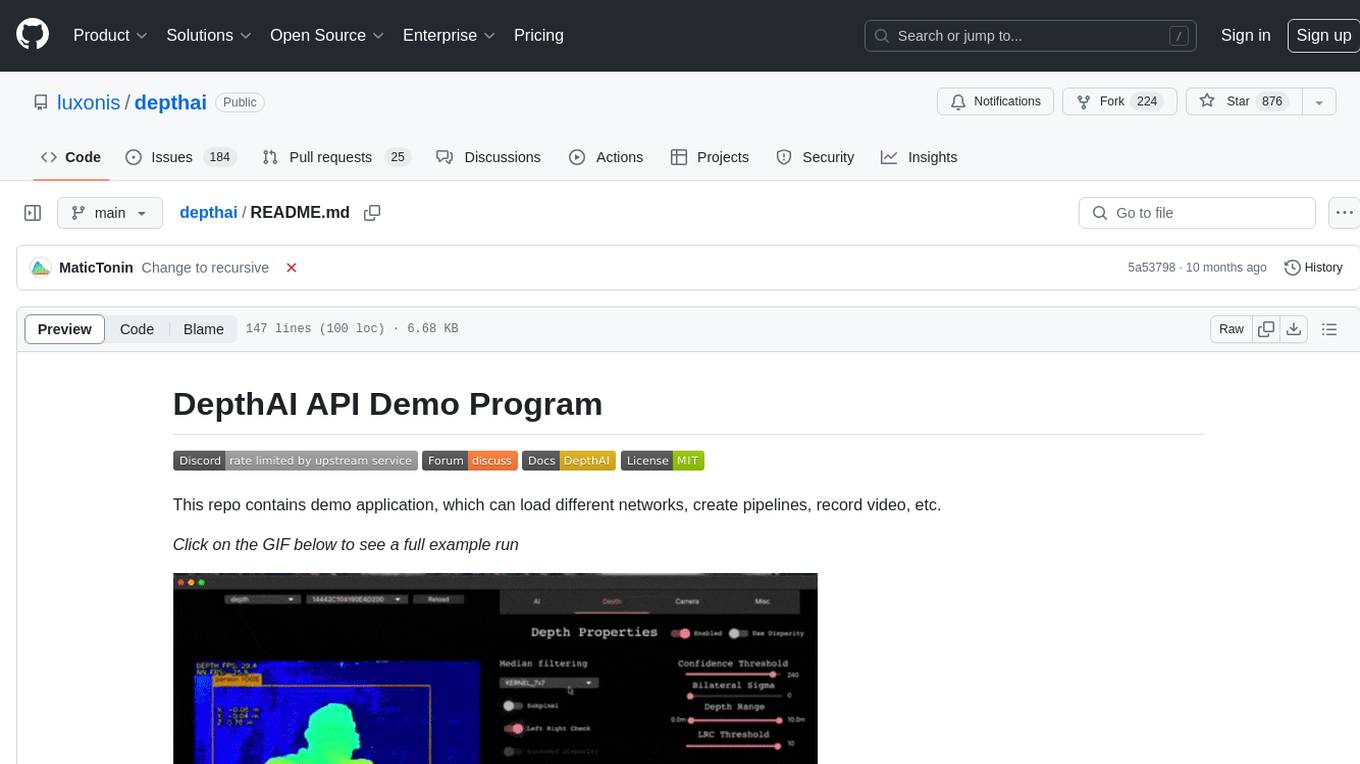
depthai
This repository contains a demo application for DepthAI, a tool that can load different networks, create pipelines, record video, and more. It provides documentation for installation and usage, including running programs through Docker. Users can explore DepthAI features via command line arguments or a clickable QT interface. Supported models include various AI models for tasks like face detection, human pose estimation, and object detection. The tool collects anonymous usage statistics by default, which can be disabled. Users can report issues to the development team for support and troubleshooting.






